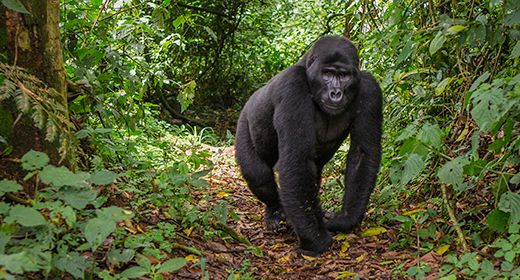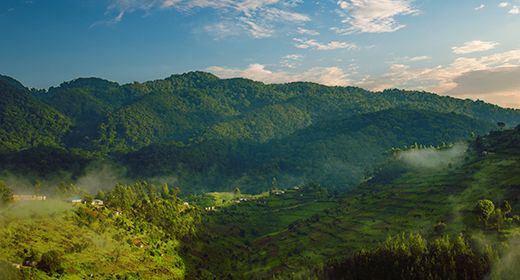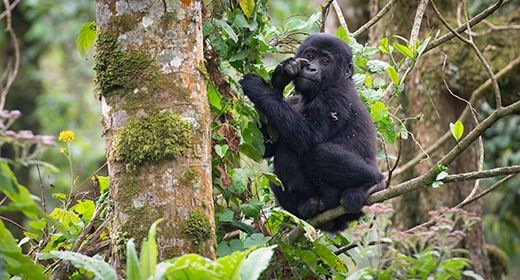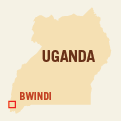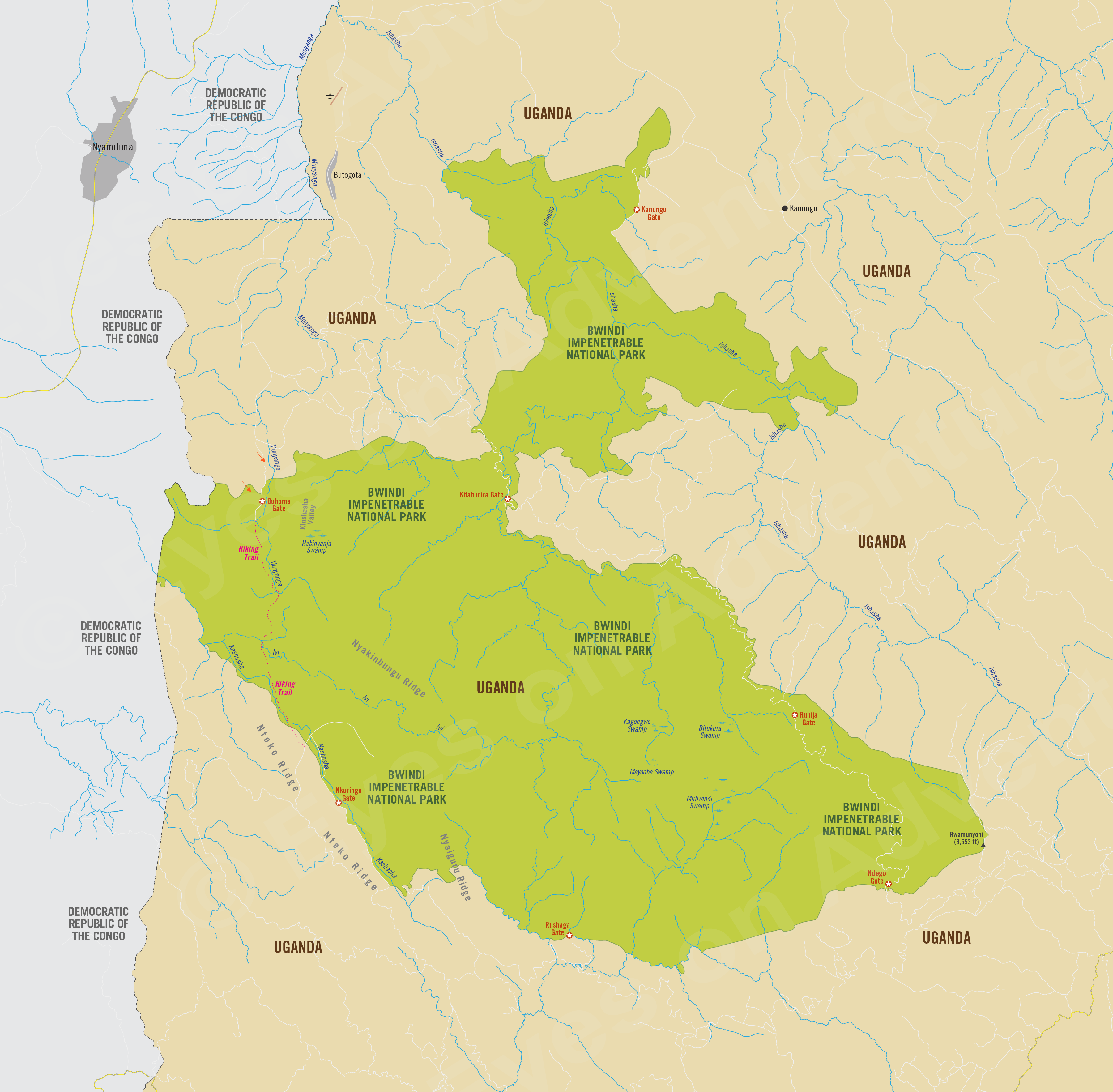Bwindi
Region Links: Bwindi
Highlights
- Mountain gorilla treks offer an amazing adventure
- More than 10 habituated gorilla groups with 100% trek success
- Extraordinary nature hikes
- One of Africa's best birding destinations
- Eleven primate species, including chimpanzees
EOA Recommends: Clouds Mountain Gorilla Lodge, Mahogany Springs Lodge, Nkuringo Bwindi Gorilla Lodge, Sanctuary Gorilla Forest Camp
Uganda's Bwindi Impenetrable Forest is one of the most biologically diverse places in Africa. It is the country's most popular wildlife destination, offering visitors guided hikes to see the endangered mountain gorillas that live in this magical rainforest.
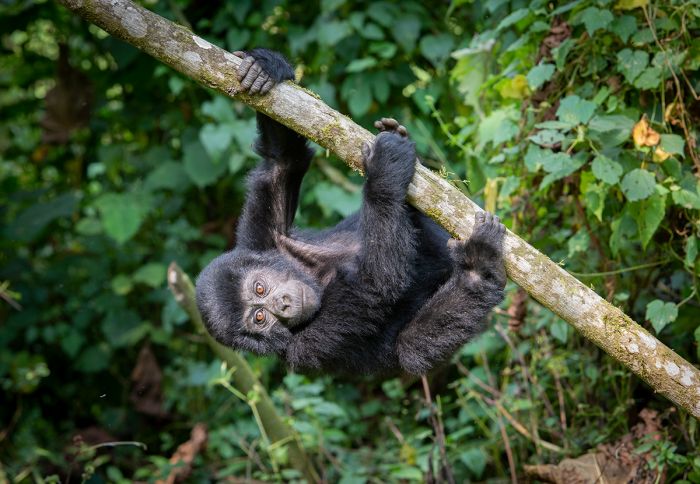
A young gorilla at home in Bwindi (Copyright © James Weis)
The mountain gorillas of the Virunga Mountains and Bwindi Forest are critically endangered, with around 1 100 individuals remaining, split into two distinct populations - one in the Virungas and the other in Bwindi.
The plight of the mountain gorilla, which is over 98% genetically identical to humans, was brought to the world's attention by Dian Fossey, who spent 18 years living with and studying the gorillas in Rwanda.
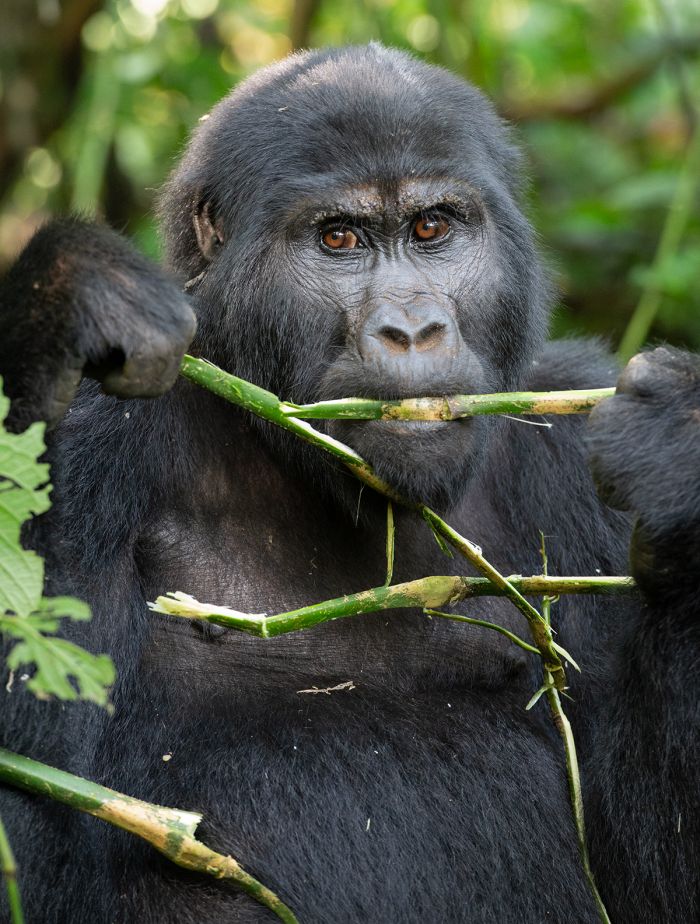
A mountain gorilla in Bwindi National Park (Copyright © James Weis)
A guided hike to visit one of the 14 habituated gorilla families in Bwindi is surely one of the world's greatest wildlife adventures. Every day, eight tourists are led on a forest trek to locate and spend one amazing hour with a gorilla family in their natural habitat. Ask anyone who has done it, and they are sure to tell you it was an extraordinary experience.
The price for a one-day gorilla permit is not inexpensive (currently USD 700 in Bwindi), but all of the proceeds go towards gorilla tourism and, over the years since gorilla treks began, it has proven very successful, with the gorilla population growing each year.
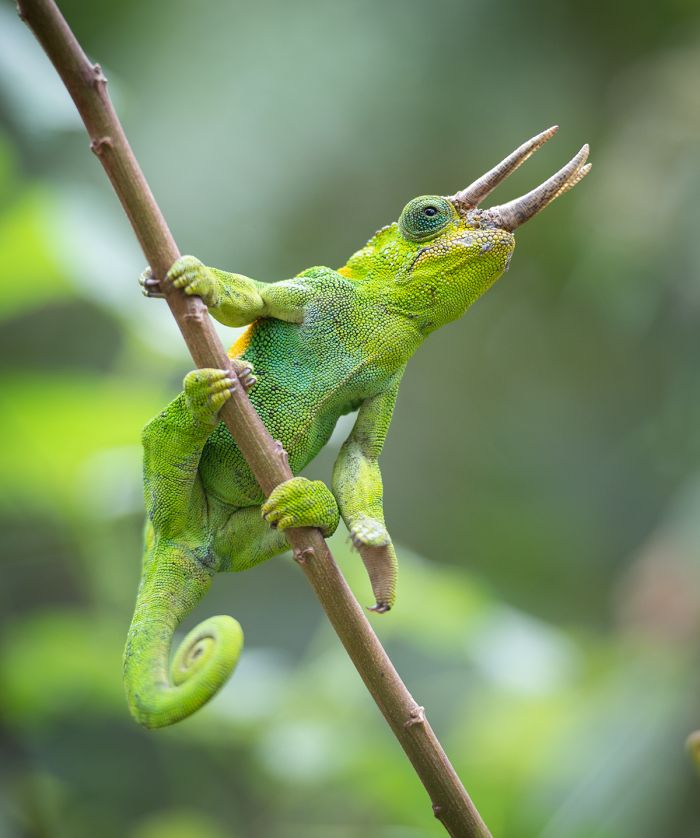
A Jackson's three-horned chameleon in Bwindi (Copyright © James Weis)
Gorilla trekking offers an almost 100% chance of seeing the gorillas, as the whereabouts of each habituated gorilla group is closely monitored. Gorilla trekking can be quite rigorous and a degree of fitness is required for the trek.
Besides mountain gorillas, Bwindi is home to another ten additional species of primate, including a healthy population of some 400 chimpanzees. Birding in Bwindi is simply amazing, with around 360 species recorded and 23 of Uganda's 24 Albertine Rift endemics are found in this forest.
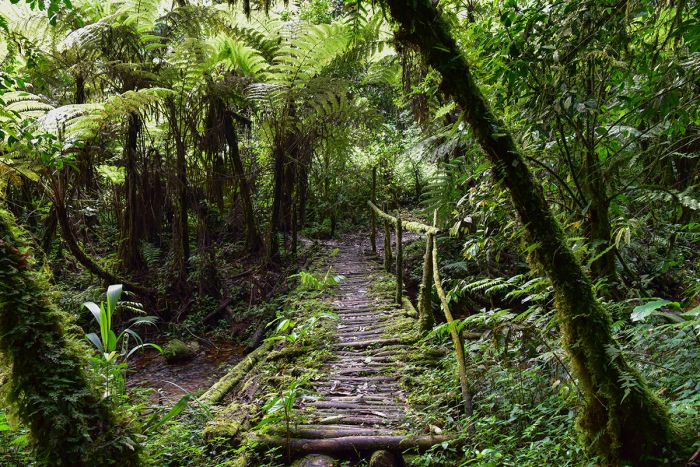
The Bwindi Forest is rich in streams and vegetation
Bwindi is also a paradise for lepidopterists, boasting 300 species of butterfly. There are numerous hiking trails in the park that offer exploration of the rainforest and its diverse plant and animal life.
Lodging at different levels of luxury is offered around Buhoma Gate / Park Headquarters, as well as further south around Nkuringo Gate.
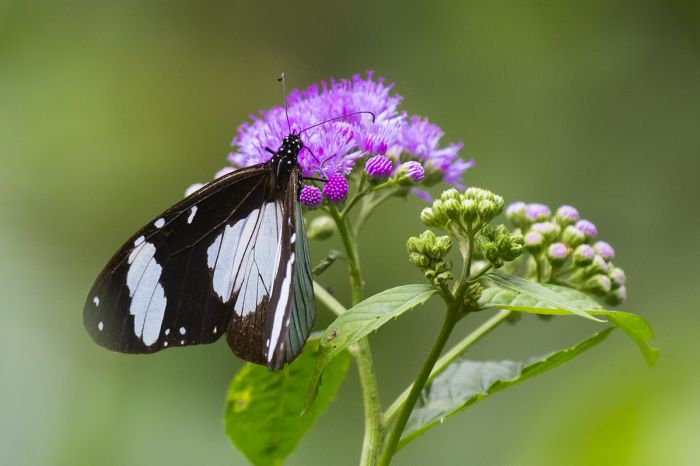
A friar butterfly (Amauris niavius) in the Bwindi Forest
Read More...
Mountain Gorillas: Activity, Diet, Discovery, Gorilla Conservation, Gorilla Tourism, Habitat, Physicality, Reproduction, Society, Taxonomy
Gorilla Trekking: Background, Clothing & Gear, Permits & Pre-Trek, Time with Gorillas, Tipping, Trekking Details, Trekking Rules, Weather
Geography/History: Flora, Geography, History, Trekking Sectors, Wildlife
History
The first protection for Bwindi Forest was established in 1932, when two blocks of forest were designated as Crown Forest Reserves by the British Colonial Authorities. These reserves had a total combined area of 80 square miles (207 sq kms). Ten years later in 1942, the two Crown Forests were combined and additional land was added to the renamed Impenetrable Central Crown Forest, which covered an area of 115 square miles (298 sq kms).
Uganda gained independence from Britain in 1962, and two years later in 1964, Bwindi's protection was upgraded to an "animal sanctuary" in order to protect its population of mountain gorillas and renamed as the Impenetrable Central Forest Reserve. In 1966, two additional tracts of forest became part of the reserve, giving it a total area of 124 square miles (321 sq kms).
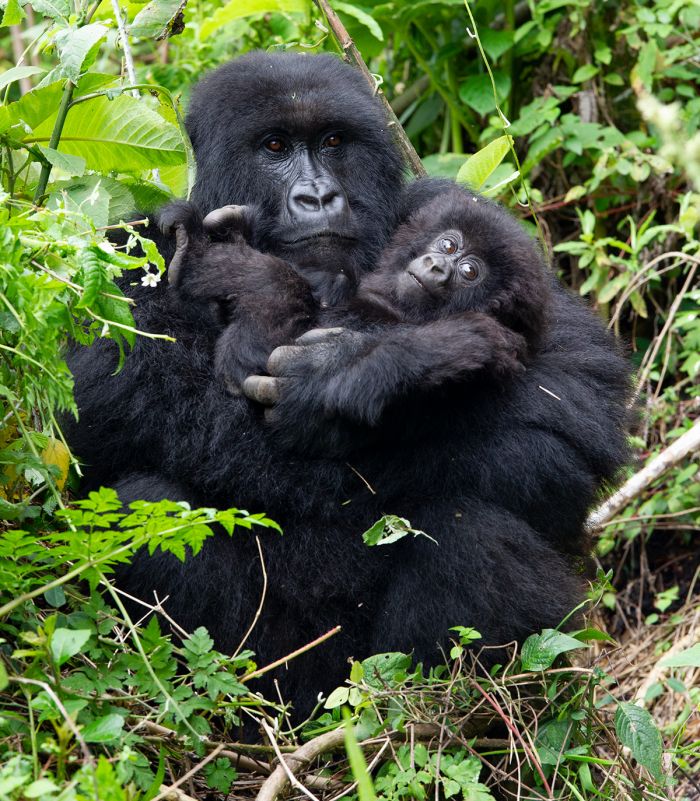
Mountain gorillas were first see by Europeans in 1902 (Copyright © James Weis)
In 1991, the Impenetrable Central Forest Reserve, the Rwenzori Mountains Reserve and the Mgahinga Gorilla Reserve were designated as national parks. The Impenetrable Central Forest Reserve was renamed to Bwindi Impenetrable National Park.
The new national park status had an extremely negative impact on the Twa (or Batwa) people (forest-dwelling hunter-gatherers), who had lived in the park for thousands of years and were now forced to vacate the forest permanently. The Twa had for many generations fished, harvested wild plants and honey, and they had ancestral sites within the park. The Twa were evicted and never compensated by the government.
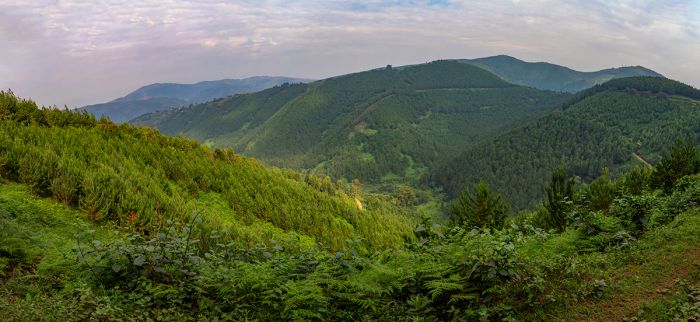
The hilly terrain of Bwindi makes for a huge diversity of flora
Due to its extraordinary biodiversity and the fact that it is home to roughly half of the world's remaining population of the endangered mountain gorillas, Bwindi Impenetrable National Park was inscribed as a UNESCO World Heritage Site in 1994.
In 1999, Rwandan Hutu rebels of the Interahamwe militia that had fled to the DRC after the Rwandan Civil War (which ended after the Rwandan genocide in 1994), crossed the border into Uganda and attacked tourists, park authorities, and rangers in Bwindi. Some were killed but most escaped with their lives. There has been no further trouble since that time.
Today Bwindi is by far Uganda's top tourist destination and gorilla trekking alone accounts for about 70 percent of the country's tourism revenue.
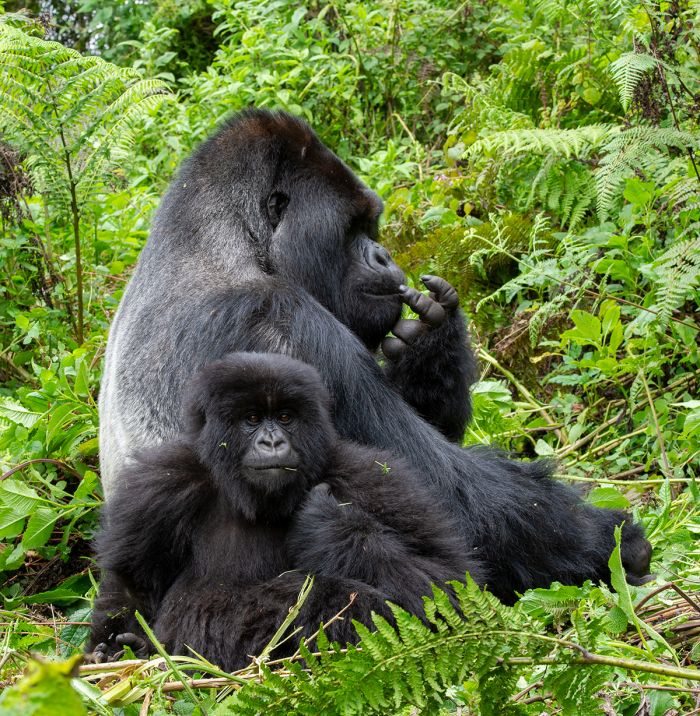
Bwindi Impenetrable Forest is Uganda's top tourist destination (Copyright © James Weis)
Geography
Bwindi is located just 0.5 degrees south of the equator, in the far southwest corner of Uganda, along the border with the Democratic Republic if the Congo (DRC) and very close to the Rwandan border. It lies along the Albertine Rift (part of the Great African Rift), which extends from the northern shores of Lake Albert to the southern end of Lake Tanganyika.
Bwindi is a true rainforest and an important water catchment area, receiving annual rainfall that ranges between 55 to 75 inches (1 400-1 900 mm). Most of its rainfall flows through a large network of streams that form tributaries flowing to several major rivers. These rivers flow either north to Lake Albert or south into Lakes Mutanda and Bunyonyi.
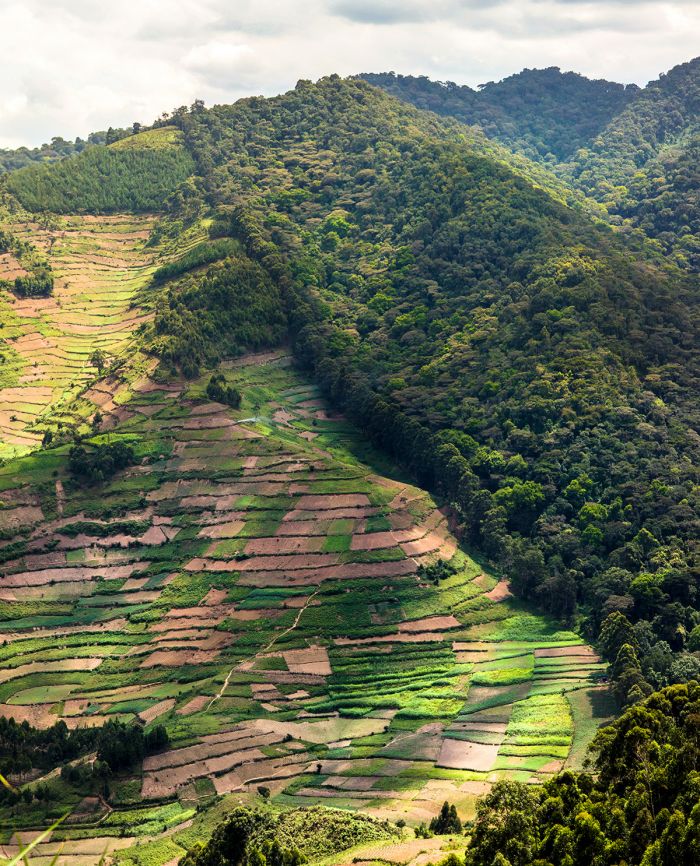
The importance of Bwindi's national park protection is evident in this image, as agriculture occurs right up to the boundary of the park
The nearest town to Bwindi is Kabale, which lies 18 miles (29 kms) southeast by road. Much of the land immediately outside the park's borders is agricultural land where there once was forest. Agriculturists began clearing forest in the region around 500 years ago and the park is virtually surrounded by cultivation.
Bwindi's topography includes elevations of 3 900-8 500 feet (1 200-2 600 meters).
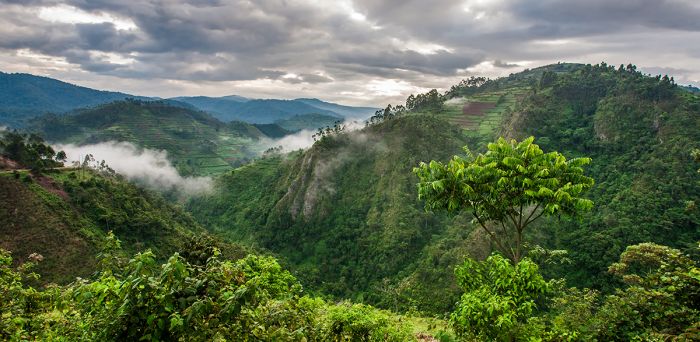
Landscape on the border of Bwindi, showing some terraced agriculture
Flora
Bwindi is one of the oldest forests in Africa, having existed for at least 25 000 years. The forest is also one of the most biodiverse on the continent, with more than 1 000 flowering plant species, including 200+ species of tree and 100+ species of fern.
The name "Bwindi" comes from the Runyakitara (a standardized language based on four closely related languages of western Uganda) word "Mubwindi", which roughly means "place of darkness". The reference is to the forest's dense stands of bamboo and other hardwood trees, plus the closed canopy, which makes for a dark forest floor in many areas.
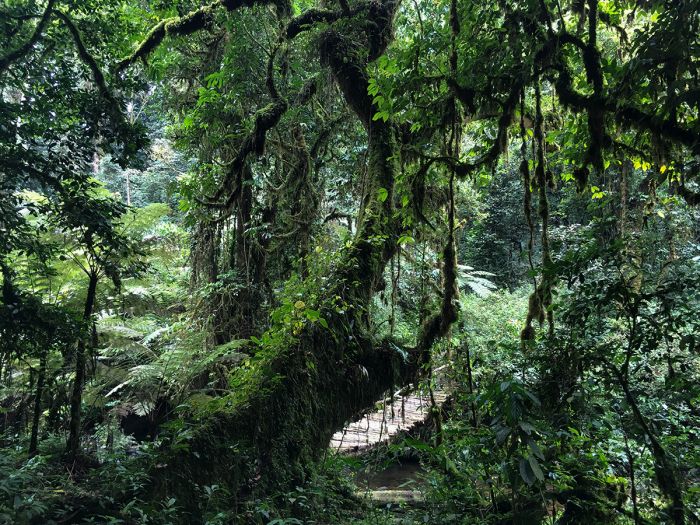
"Bwindi" translates as "place of darkness", referring to its dense forest
The huge diversity of flora in Bwindi is partly due to the fact that during the last Ice Age, the forest did not dry out, making it one of the last refuges for many species. Bwindi's tropical climate and the variation in elevations also contributes to its great diversity of plants.
Bwindi's vegetation is described as afro-montane forest, which is uncommon on the continent and occurs where grasslands meet mountains and there is a continuum of low- to high-altitude primary forest. The forest also boasts a high rate of endemism among its flora, with many Albertine Rift regional endemics, including the habitat-endangered brown mahogany tree.
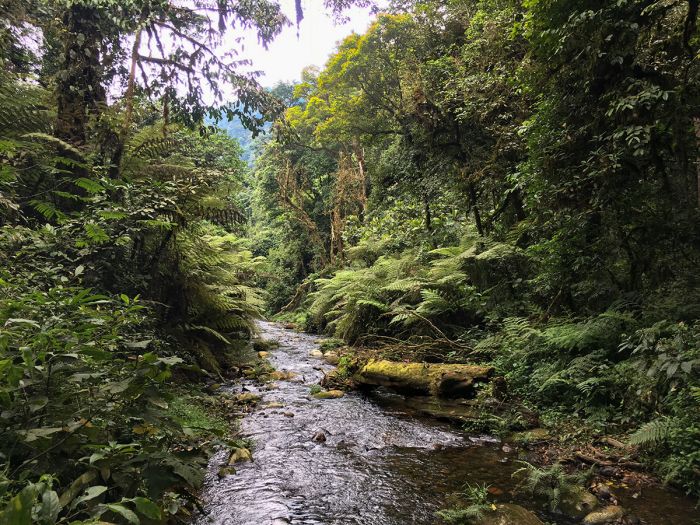
Bwindi receives a lot of rain and is interspersed with myriad small streams
Wildlife
Bwindi is home 500-600 mountain gorillas, which accounts for roughly 50 percent of the world's remaining population (the other half live on the volcanic slopes of the Virunga Mountains in Rwanda, Uganda, and the DRC). Bwindi Forest is home to an astounding 120 species of mammals, including giant forest hog, side-striped jackal, African golden cat, African civet, and numerous rodents and bats. There are six antelope species, including bushbuck and five species of forest duiker.
Bwindi is also home to a small population of elephants (assigned to the 'forest' race), living in the southeast of the park, but they are timid and seldom seen. Buffalo and leopard were once common in Bwindi, but are now extinct.
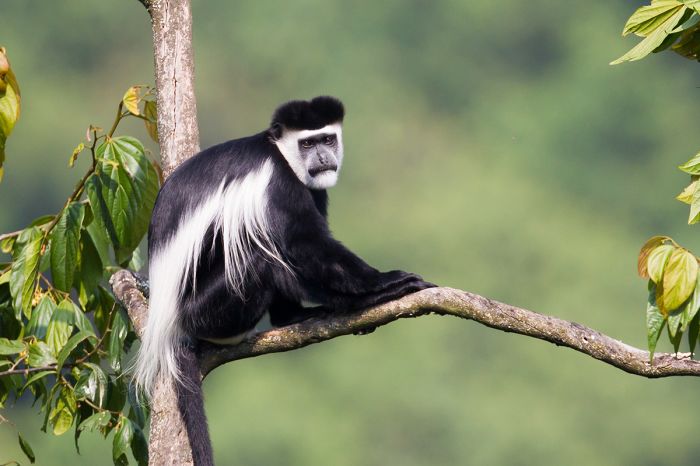
A male black-and-white colobus monkey in Bwindi NP
Including the mountain gorilla, Bwindi harbors eleven species of primate, including a healthy population of chimpanzees and good numbers of L'Hoest's, blue, vervet, and red-tailed monkeys. Other primates include olive baboon, black-and-white colobus monkey, and three nocturnal species: potto, Demidoff’s galago, and spectacled galago.
Birding is Bwindi is nothing short of spectacular. Roughly 350 avian species have been recorded, including 25 range-restricted species and flour globally threatened species (Grauer's broadbill, Grauer's swamp warbler, Chapin’s flycatcher, and Shelley’s crimsonwing).
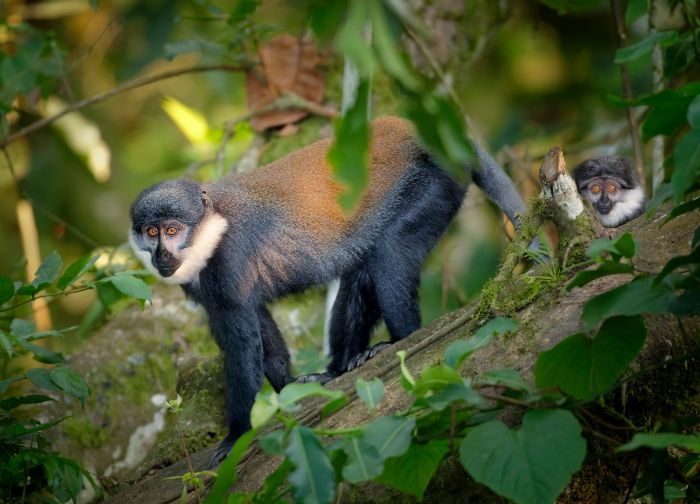
Bwindi is home to 11 primate species, including L'Hoest's monkey (Allochrocebus lhoesti)
Bwindi's wildlife list also includes twenty-seven species of amphibian, eleven of which are Albertine Rift endemics, fourteen snakes (nine are endemic to Bwindi), six species of chameleon, and fourteen lizards.
Lepidopterists will enjoy themselves in Bwindi, as there have been 220 species of butterfly recorded, three of which are endemic to Bwindi, and a day of hiking should provide 50 species.

Bwindi boasts 220 species of butterfly like this African Swallowtail (Papilio dordanus)
Gorillas
Discovery
The first gorilla was 'discovered' by Thomas Staughton Savage, an American Protestant clergyman, missionary, physician and naturalist. In 1836, Savage was sent as a missionary to Liberia. During his time in Africa he acquired the skull and bones of an unknown ape species. In 1847, together with American naturalist and anatomist Jeffries Wyman, Savage described the newly discovered ape as Troglodytes gorilla. Savages' gorilla bones were those of the western lowland gorilla.
Mountain gorillas were first 'discovered' by the German army officer and explorer Friedrich Robert von Beringe in 1902 during an expedition on Mount Sabyinyo in present-day Rwanda. Von Berenge's team managed to shoot one gorilla and had its body returned to Germany, where it was described as a new species and given the scientific name Gorilla berengei.
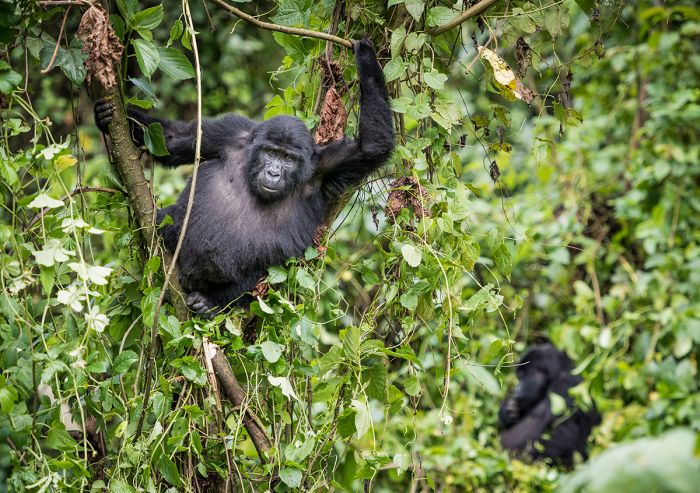
The Bwindi Forest is home to one-half of the world's mountain gorillas
Taxonomy
All gorilla species belong to the taxonomic family Hominidae, which includes the "great apes". There are four existing genera in the family: Gorilla, Pan (bonobos and chimpanzees), Pongo (orangutans), and Homo (humans).
Sometime between 12 and 18 million years ago, the family of Hominidae, split into two subfamilies, with humans, chimps and gorillas branching off into Homininae, and orangutans into Ponginae. Later, between 8 and 10 million years ago, Homininae further split into two tribes, with gorillas branching into Gorillini and humans, chimps, and bonobos branching into Hominini. Humans and chimps/bonobos branched into separate species between 6 and 8 million years ago.
In terms of gorillas, debate over their proper classification has been ongoing since their discovery in 1847. Originally assigned to the genus Troglodytes, they were later given the genus Gorilla in 1852.
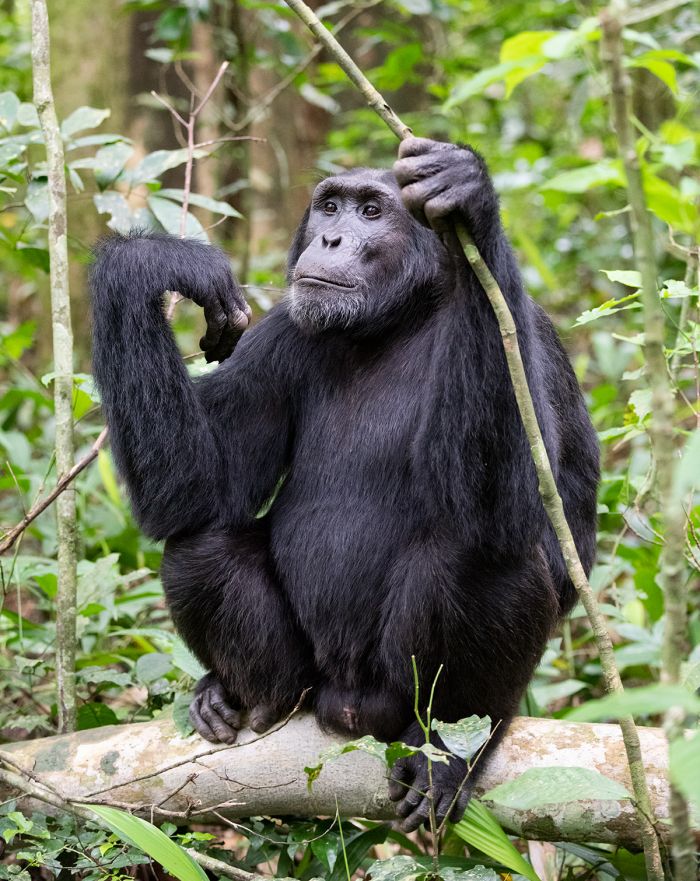
Bwindi is also home to chimpanzees (Copyright © James Weis)
All species of extant gorillas have been classified as the same species (Gorilla gorilla) since 1967. Within the species are four existing subspecies: G.g. beringei (mountain gorilla, living in the Virunga Mountains and Bwindi); G.g. graueri (eastern lowland gorilla, living in the lowland forests of eastern DRC); G.g. gorilla (western lowland gorilla, living in the lowland forests of central and west Africa); G.g. diehli (Cross River gorilla, living in a small patch of forested mountains and highlands in Cameroon and Nigeria).
All four subspecies of gorilla are believed to have descended from a single type of gorilla that once ranged throughout the expansive Congo River basin, which covers a huge area from the Atlantic Ocean coast to Central Africa's western Rift Valley. The various subspecies developed due to range fragmentation that occurred during dry periods in the last Ice Age, which peaked some 18 000 years ago. During the dry periods, the vast rainforest in which the gorillas dwelled was fragmented, resulting in geographic isolation and eventual subspeciation within the gorillas.
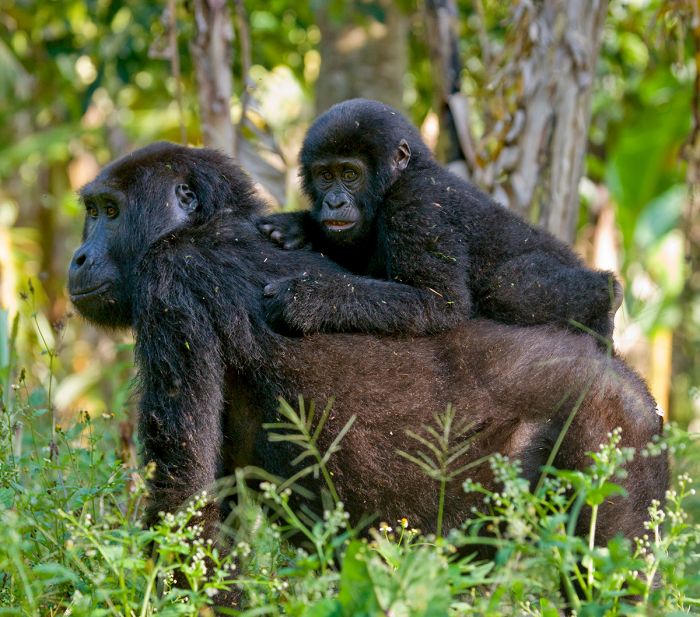
A young mountain gorilla gets a ride in Bwindi NP
Within the mountain gorilla subspecies (Gorilla gorilla beringei), there are two distinct populations surviving today, one in Bwindi Impenetrable National Park in Uganda and the other in on the slopes of the Virunga Mountains, which span the countries of Rwanda, Uganda, and the DRC. Discussion is ongoing regarding a possible split of the Bwindi and Virunga populations into separate subspecies.
Genetic studies of the base components of all genes shared by gorillas, chimpanzees, and humans reveal that all three species are very closely related, which would be expected as our divergence was relatively recent as described above.
Genetic sequencing indicates that the differences between individual humans, regardless of race and physical characteristics, is only 0.1%. Differences in genomes between humans and chimpanzees/bonobos, our closest relatives on an evolutionary basis, is around 1.2%. Genomic differences between our next closest relatives, gorillas and orangutans, are 1.6% and 3.1%, respectively.
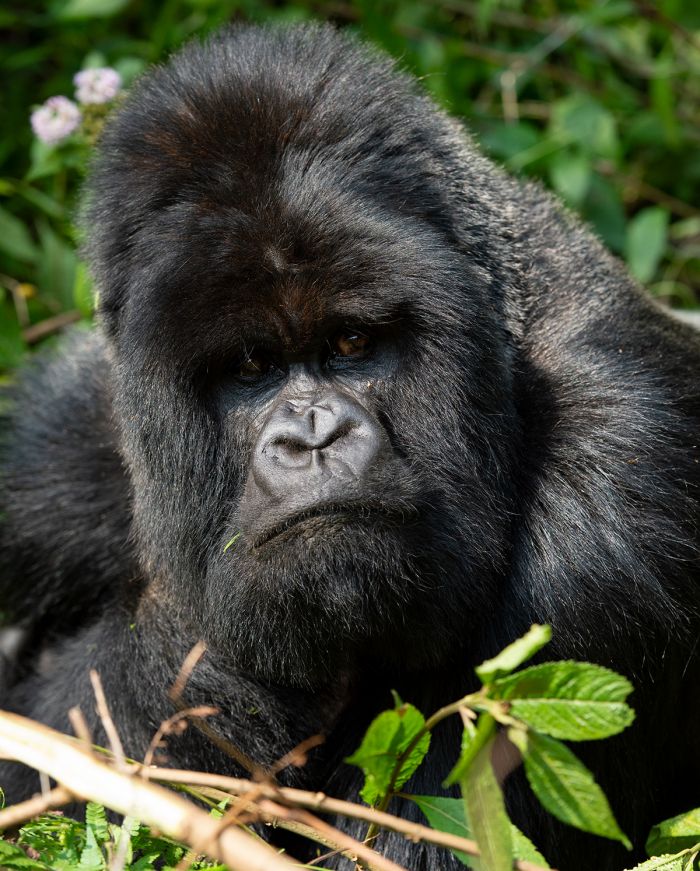
There are two gorilla populations: one in Bwindi and the other in the Virunga Mountains (Copyright © James Weis)
Physical Characteristics
Mountain gorillas are sexually dimorphic, with significant size differences between adult males and females. Adult males have an upright standing height of 55-63 inches (140-160 kms) and weigh between 330-420 pounds (150-190 kgs), while females stand 51 inches (130 cms) and have a weight of around 220 pounds (100 kgs).
The fur of the mountain gorilla is thick and black, but some individuals have brownish coloration on their heads. As males reach maturity, they develop silver-colored hair on their backs, which has given such adult males the nickname of "silverback".
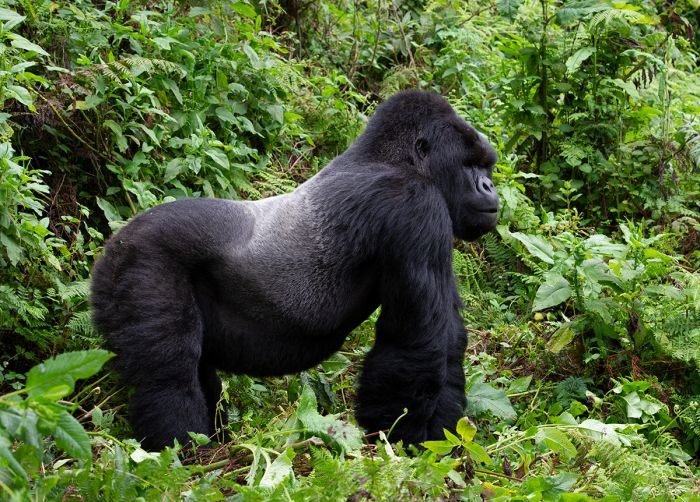
An adult male "silverback" weighs between 320-420 pounds (Copyright © James Weis)
Habitat
There are two geographically distinct populations of mountain gorilla, one in Uganda's Bwindi Forest and the other in the Virunga Mountains, a range of eight volcanoes that straddle the borders between Rwanda, Uganda, and the DRC.
The size of each of the gorilla populations is between 500-600 individuals, which results in a total population of around 1 100 mountain gorillas. Just 31 miles (50 kms) separates the borders of the two mountain gorilla ranges, but the forest that once connected them has long been removed by humans, primarily for use in agriculture.
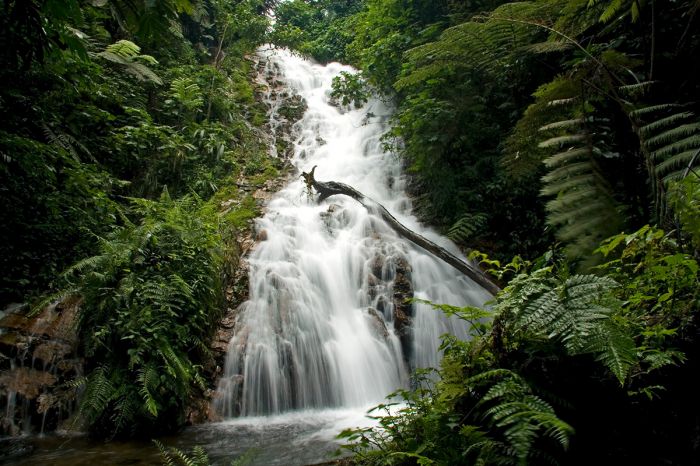
The lush Bwindi Forest is home to half the world's mountain gorillas
Mountain gorillas spend most of their time in montane and lowland forests, with elevations in the Virungas ranging between 7 200-14 100 feet (2 200-4 300 meters) and those in Bwindi ranging between 3,900-8,550 feet (1 190-2 600 meters).
The forests in both Bwindi and the Virungas are characterized by dense vegetation in the lower elevations and becoming sparser at higher elevations. These primary forests are lush and receive substantial rainfall, making for a misty and often cloudy environment.
Mountain gorilla families have a home range, the size of which varies depending on the current availability of their preferred food sources. The Virunga gorillas have a home range that covers between 1.5-3 square miles (4-8 sq kms). Fruiting trees are much more prevalent in Bwindi, so the Bwindi gorillas generally have a much larger home range than those in the Virungas, moving around to take advantage of individual trees bearing fruit.
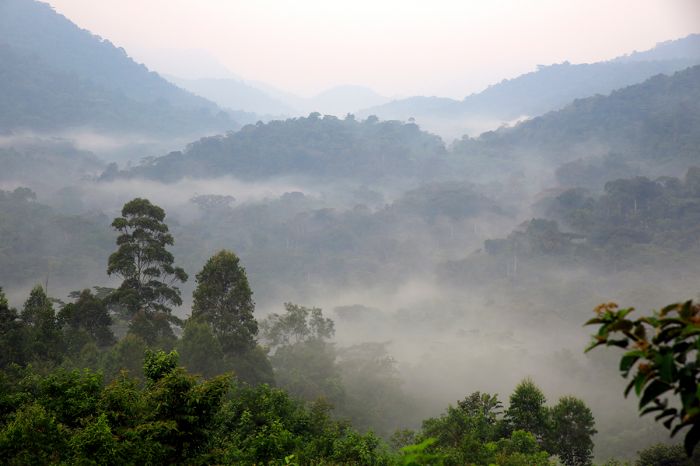
Clouds often cloak the canopy of Bwindi's forest
Social Structure
Mountain gorillas, like all subspecies of gorilla, are highly social animals that live in family groups. A mountain gorilla "family" or group can number between 5 and 30 individuals, but the typical group includes between 10 and 15 individuals. All families have a dominant male "silverback" that is the overall leader of the group.
A typical mountain gorilla family includes one or two "blackbacks" (younger, subordinate males that are often related to the dominant male), several sexually mature females (some are bonded partners of the silverback and some may be his offspring), and numerous juveniles and babies.
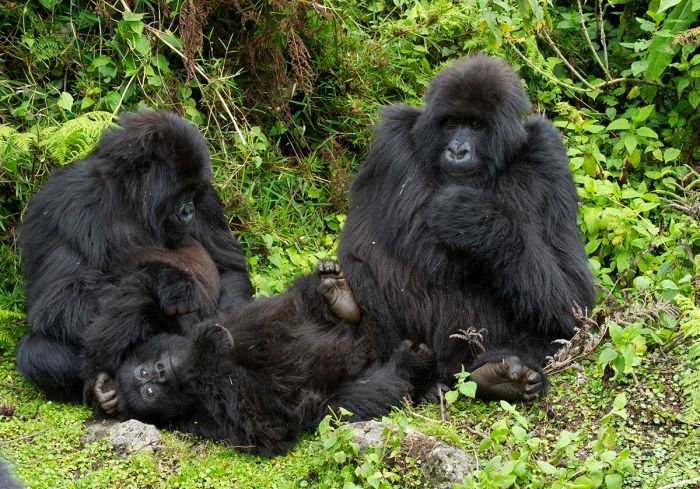
Gorillas live in highly social family groups (Copyright © James Weis)
The dominant silverback leads the gorilla family and determines the timing and direction of activity, including feeding locations and overnight sleeping spots. He also mediates any disputes within the group and acts as the primary defender against any external threats (although all adult gorillas will fight when necessary to protect the group).
During the mid-day relaxation time, the dominant silverback becomes the center of the group's attention, especially with the juveniles, who usually remain close to him and include him in their play.
Almost all gorillas emigrate from their natal group when they approach sexual maturity, in order to join another gorilla group. Female mountain gorillas leave their group beginning at about 8 years of age, while males wait a bit longer, only leaving at around age 11.
On rare occasions, a male may remain in his father's group if the dominant silverback is old and there is a chance for the younger male to inherit the group, but most often when this occurs, another older, stronger, and more experienced male from another group will overthrow the younger gorilla.
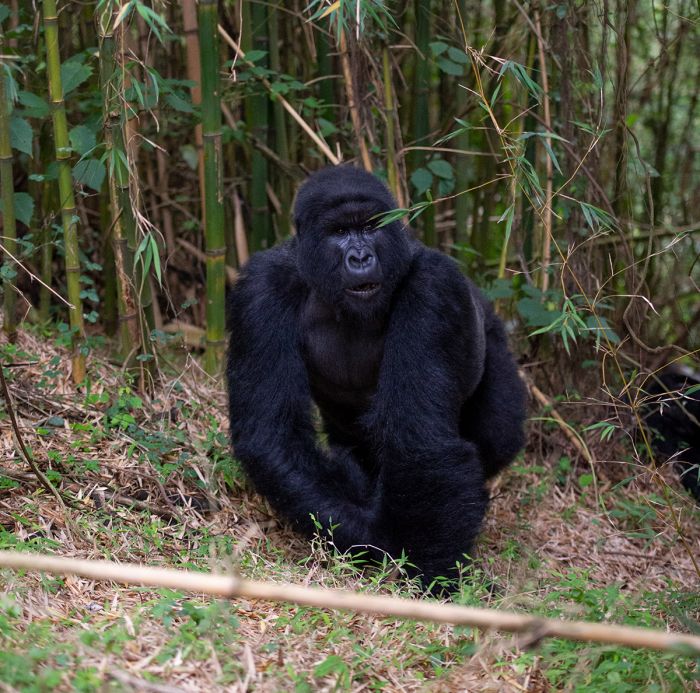
A dominant male "silverback" leads and protects each gorilla group/family (Copyright © James Weis)
When a female mountain gorilla decides it is time to leave her natal group, she is almost always accepted immediately by another established group or perhaps by a lone male that is waiting for a chance to start his own group.
Emigrating males often travel with an all-male group for two to five years after leaving their birth group, gaining strength and size until they are able to attract emigrating females or attempting a takeover of an existing gorilla group.
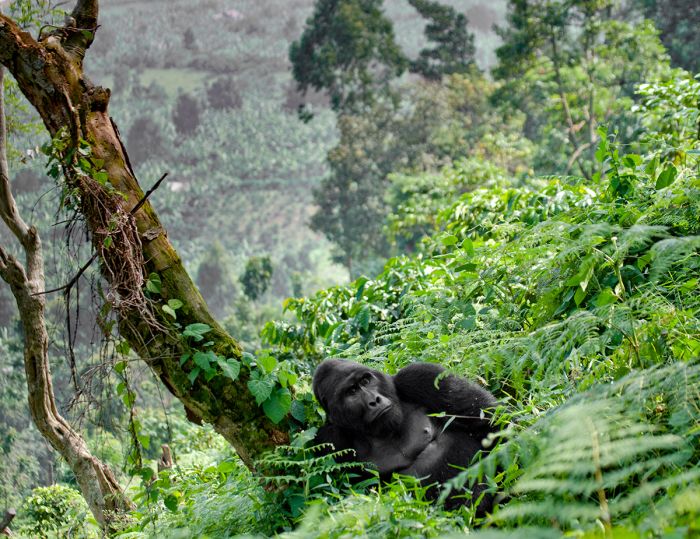
Males emigrate from their natal family group and spend some years alone or traveling with other males before joining another group or starting their own group
Diet
The diet of mountain gorillas is almost completely vegetation-based and consists of over 100 species of plants that includes various leaves, stems, shoots, flowers, roots, and bark. They also eat some protein-based foods, including grubs and insects.
The diet of Bwindi's gorillas consists of a much higher percentage of fruits and pith than that of the Virunga population, as the Bwindi Forest's lower elevations sustain plenty of fruiting trees, while the much higher-elevation Virunga Mountains do not. For this reason, adult gorillas in Bwindi are much more likely to climb trees than those in the Virungas. During months with high fruit availability, Bwindi's gorillas will feed predominantly on fruits during certain days and alternate with days of fibrous foods.
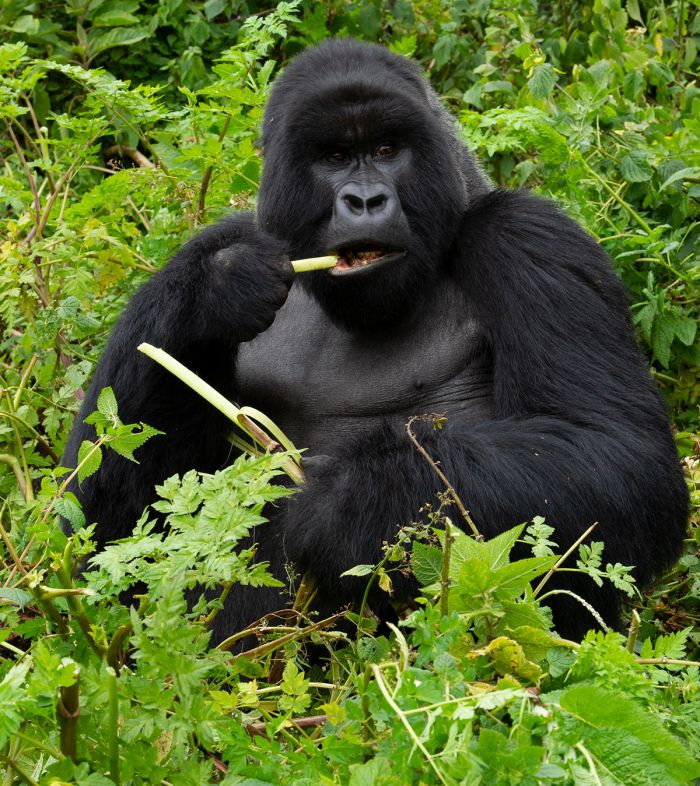
Adult males eat 75 pounds of vegetation daily (Copyright © James Weis)
The gorillas in both the Bwindi and Virunga populations are primarily folivory (leaf-eaters), with diets consisting primarily of herbaceous leaves, but the Bwindi gorillas consume more tree leaves while the Virunga gorillas consume leaves primarily from terrestrial plants, like stinging nettles and vines. Although the diets differ between the two gorilla populations based on specific plant species, both contain very similar concentrations of nutrients, crude protein, fiber, and non-structural carbohydrates.
Adult male mountain gorillas consume around 75 pounds (34 kgs) of vegetation per day, while the smaller females eat about half as much. The gorillas' plant-based diet causes large amounts of gas to form in their gut, which leads to their characteristic bloated stomachs and frequent flatulence. Interestingly, gorillas seldom drink water, as they gain all needed moisture from the succulent herbaceous plants they consume.
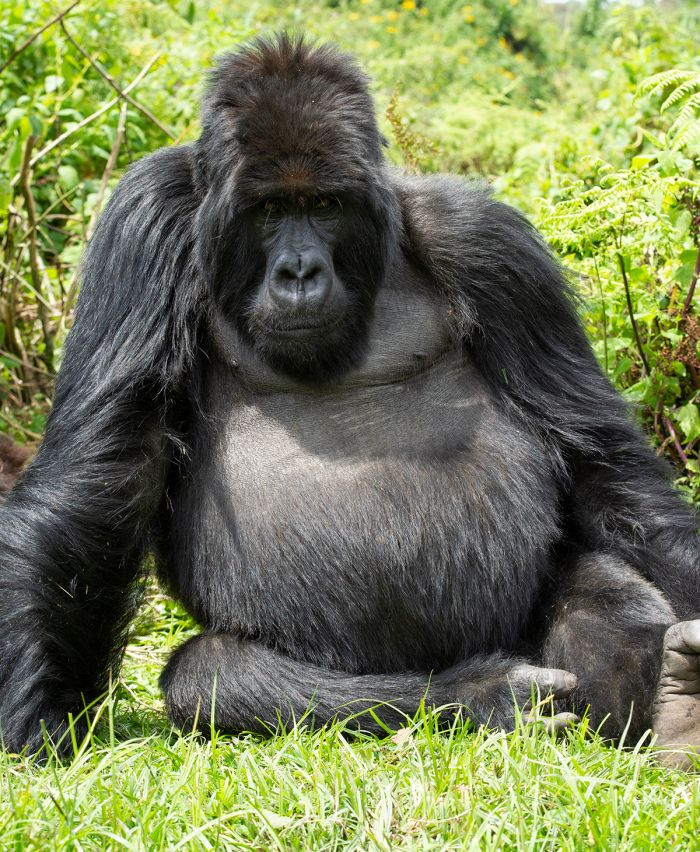
The mountain gorilla's diet causes characteristic bloating (Copyright © James Weis)
Mountain gorillas do not share food among members in their family, but neither do they compete over specific food items. When there is limited access to a specific food item, the dominant silverback will usually monopolize the best feeding spot and the others in the group will defer to him until he moves. Normally, when a group is foraging, the members spread out, as food is almost always present in abundance.
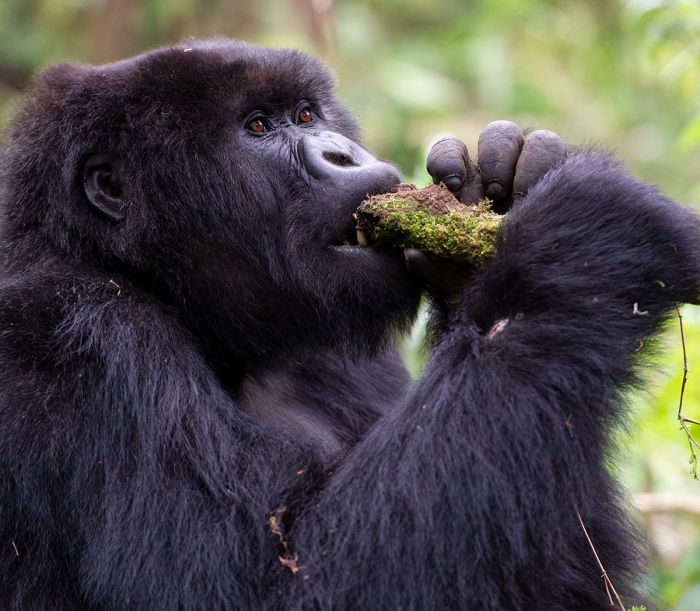
Mountain gorillas consume a large variety of plants (Copyright © James Weis)
Activity
Mountain gorillas spend about one-third of their waking hours foraging and feeding, another one-third moving between feeding locations within their home range, sometimes feeding along the way, and the remaining time resting. Younger gorillas may also play during the feeding and resting periods.
The entire gorilla group engages in the same behavior and the patterns of activity at the same time and it generally follows the same pattern each day. Early mornings are spent warming up in the sun for a bit on cold days, followed by their peak moving and feeding period during the first four hours of the day. Middays are usually spent as an extended rest period. After resting, the mid- to late-afternoon consists of another foraging period, which lasts several hours
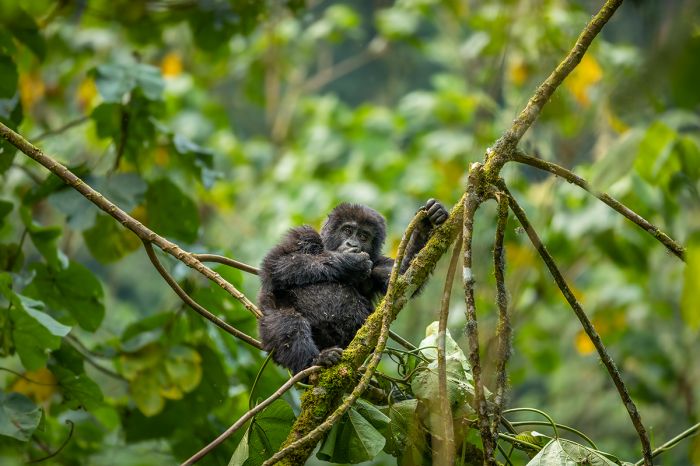
A very young mountain gorilla in Bwindi Impenetrable NP
Like most humans, mountain gorillas are diurnal, sleeping during the night and they do not move around or feed after dark. Before retiring for the day, each gorilla makes a nest, which serves as their bed for the night's sleep. Nests are constructed from soft vegetation, stems, and branches and construction typically takes around five minutes.
A new nest is built every night by each gorilla because the gorillas move around their home range every day and sleep in a different location night to night. Infants sleep with their mother until about 3 years of age or until their mother gives birth again. Bwindi's gorillas are more often seen sleeping in trees than those in the Virungas. This is due to the fact that the Bwindi population spends far more time in trees, which they climb to feed on fruits.

Mountain gorilla spend one-third of their waking hours foraging and feeding (Copyright © James Weis)
Reproduction
Gorillas, like all of the great apes (including humans), reproduce at a very slow rate. Mountain gorillas average four to five years between births, unless a baby dies, in which case the female will become sexually receptive again within about twelve months.
A female mountain gorilla typically lives 40 to 50 years, during which time she may have up to six offspring. A female becomes sexually mature at about seven years of age, while males remain sterile until they reach 11-13 years. The gestation period for mountain gorillas is 8.5 months.
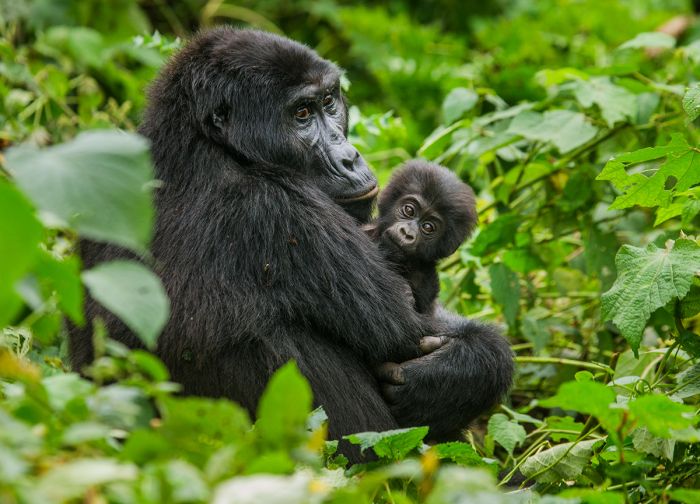
A female mountain gorilla with her baby in Bwindi
A female's estrus period lasts around two days, and during this time, mating takes place about once per hour during daylight hours. Sometimes a group may have more than one female in estrus simultaneously, which makes for busy days for the dominant silverback.
Mating is typically initiated by the female and is only with the group's dominant silverback. Loud vocalization by both the male and female occurs during mating. These vocalizations often attract the attention of other gorillas in the vicinity, especially solitary males or males from a neighboring gorilla group. It is during these times of interaction between gorilla groups that females may emigrate to join a male outside her natal group. Fights between males can also occur during these interactions.
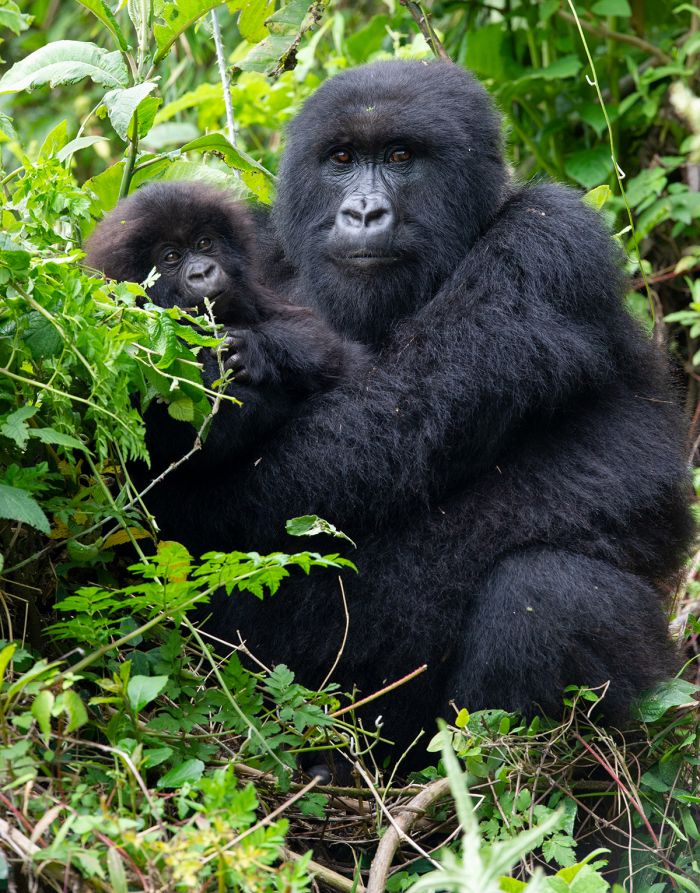
The gestation period for mountain gorillas is 8.5 months (Copyright © James Weis)
GORILLA TREKKING
Background
The experience of going on a guided trek to visit a mountain gorilla family is undoubtedly one of the world's greatest wildlife adventures. Being able to get up close to these close relatives of mankind is thrilling and humbling. If you're looking for something beyond the classic game drive safari, this should be at the top of your list!
Gorilla trekking is offered in both the Virunga Mountains and in Bwindi. The Bwindi gorilla treks take place from four main locations in the park: Buhoma in the northwest (from park headquarters), Nkuringo in the southwest, Ruhija in the southeast, and Rushaga in the south (see more on trekking sectors below).
The gorilla trekking activity focuses on specific gorilla groups that have been "habituated" over many months (by guides and park rangers) to seeing humans on a daily basis. This habituation process eventually means that the gorillas become very comfortable with human visitors, to the point where they hardly take notice.
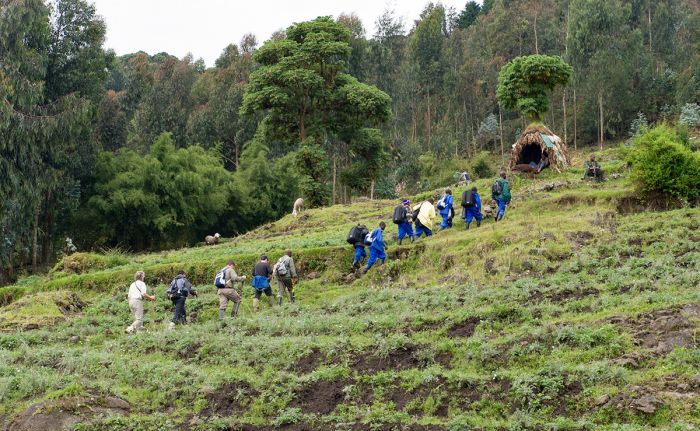
A group of trekkers en route to see mountain gorillas (Copyright © James Weis)
Over time, the habituated gorillas learn to trust that the human visitors are not a threat and the guides also build a personal relationship with individual gorillas. The gorilla trekking guides use vocalizations that mimic those used by subordinate members of the group in order to show deference to the dominant silverback. You may notice that your guide vocalizes using grunts or moans during your time with the gorillas.
As in Rwanda, the Bwindi gorilla groups are are visited only once per day and for only one hour of interaction with a maximum of eight tourists. In Rwanda's Volcanoes National Park (the other main gorilla trekking location) there are 10 habituated gorilla groups, while in Bwindi, there are 14 habituated groups.
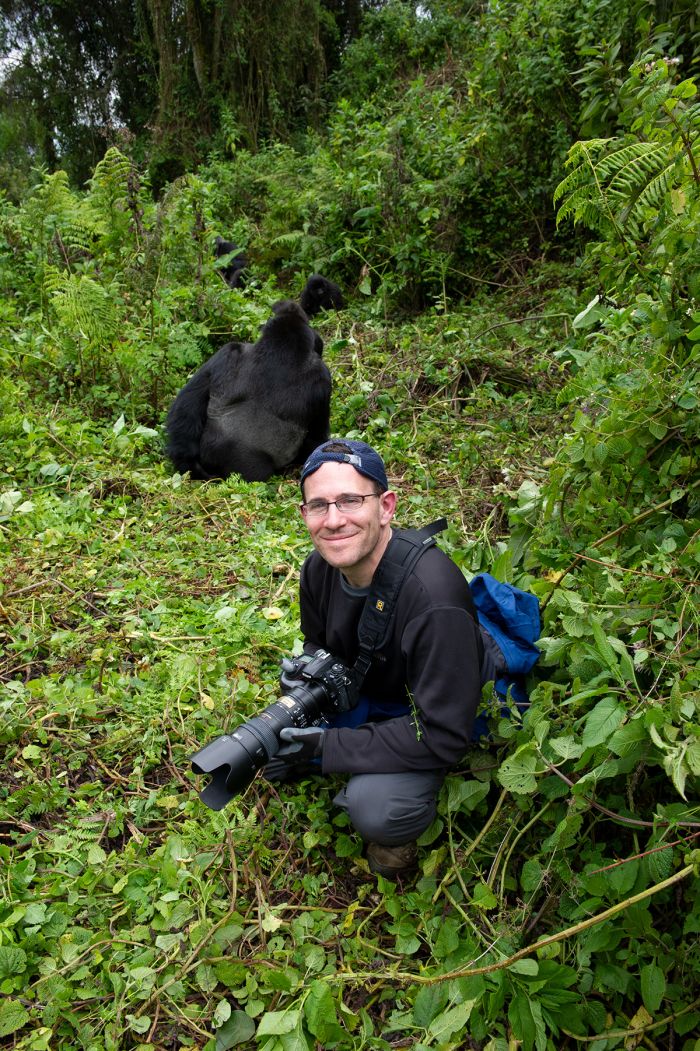
Gorilla trekking is an incredible experience (Copyright © James Weis)
Permits and Pre-Trek Details
In both Bwindi and the Virungas, gorilla trekking requires the purchase of a trekking "permit". Permits can be purchased on your behalf by your travel agent, a trekking operator, or you can purchase directly from the national park authorities. Permits are good only for a specific day and a specific person; transfers are not permitted.
While it is possible to show up on your planned day of trekking without a permit and purchase one, there is a good chance, depending on the time of year, that all permits for that day will be sold out. During the busier dry-season months, gorilla permits are almost always sold out far in advance.
Permit Pricing: The price of a gorilla trekking permit in Bwindi is currently USD 700. This is slightly lower than a permit for Rwanda's Volcanoes National Park, which is USD 750.
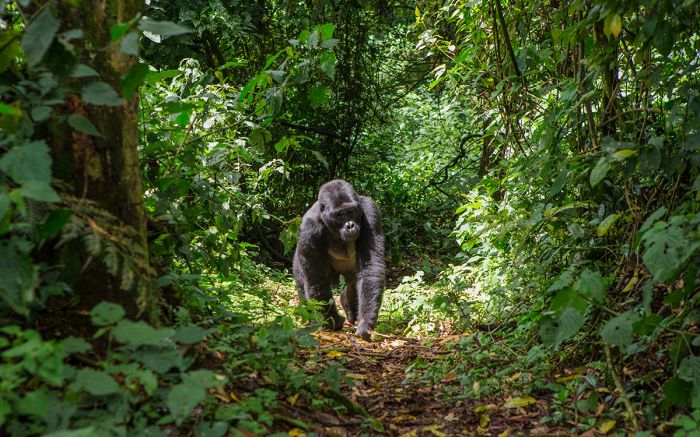
Gorillas are sometimes encountered near the camps in Bwindi
On the day of your trek, you will meet at one of Bwindi's four trekking trailheads in the early morning, where you will present your trekking permit and be assigned to a guide and a specific gorilla group for that day's trek. Permits are checked against purchase records and you are required to present your passport to confirm your identity.
The hiking conditions for your trek will depend on several factors: the location of 'your' gorilla group, which dictates how far your will hike, the conditions on the ground, which is dependent mostly on whether there has been recent rain, and the current day's weather. Gorilla groups in Bwindi tend to move around much more than those in the Virungas, so it is more difficult to gauge the length of a trek in advance.
A degree of physical fitness is required for gorilla trekking, as it almost always involves hiking through thick vegetation, uneven and sometimes muddy trails, steep sections going both up and down, and portions when you may need to climb over or under fallen trees or other vegetation.
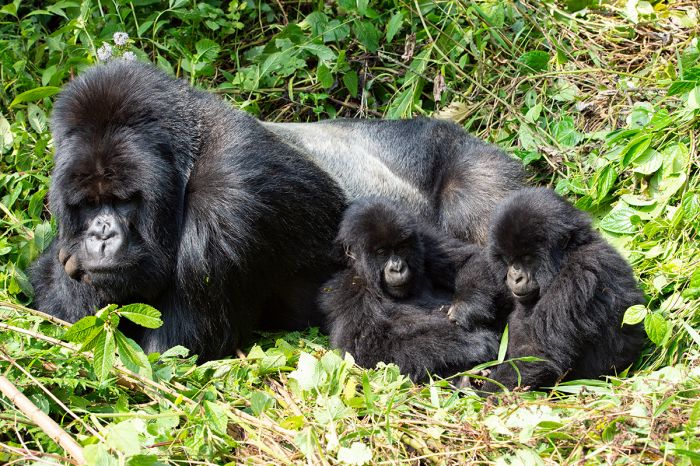
The dominant silverback relaxing with some of his offspring (Copyright © James Weis)
Regardless of your fitness level, you will be traversing terrain at elevations of 3 900-8 500 feet (1 200-2 600 meters) where the air likely contains lower oxygen levels than what are used to. The guides are very good at pacing the group to allow for slower trekkers and ensuring that everyone is able to complete the trek safely and without over-exertion.
Preparing for a gorilla trek in advance is a good idea. Exercising regularly at least one month before your trip will help you build up endurance. Stair-climbing, hiking, walking, cycling, and other cardiovascular activities, as well as exercises that build leg strength are particularly helpful.
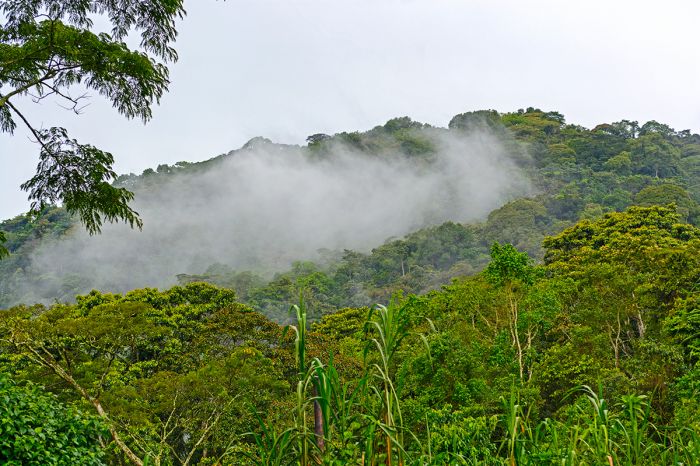
Bwindi is a true rainforest with a tropical climate
Trekking Details
The gorilla treks originate at one of Bwindi's four starting points/gates (Buhoma, Nkuringo, Rushaga, or Ruhija) at around 7:00am, where the guides, porters, and security guards will meet the tourists. Everyone must be sure to bring their passport and trekking permit with them.
Once all trekkers are checked in and their permits are validated, they are divided into groups of eight and meet their guide, who will brief his or her group. The guide will answer questions and go over details of the day's trek, including information on the gorilla group to be visited.
At the starting point, trekkers will have the option (highly recommended) to hire a personal porter to carry their backpack. Walking sticks (no charge) will also be offered (very helpful and also recommended). Hiring a porter not only lightens your load (trust us, you will be glad you did), but it also helps support the local community and invests these individuals in gorilla tourism and gorilla conservation.
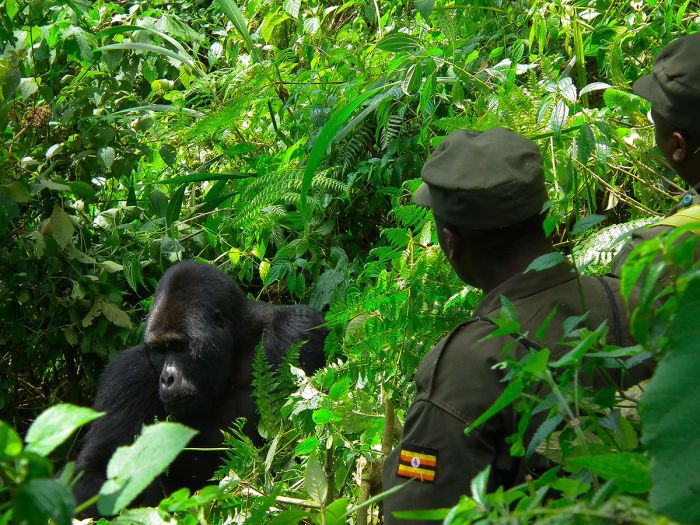
Expert guides accompany all gorilla trekking groups in Bwindi
Before the trek begins, the guide will be in radio contact with the gorilla trackers, who will most likely already be with your gorilla family. The trackers depart at first light to find the gorillas, beginning where they left them the prior evening. In this way, each gorilla group is monitored, so that finding them is almost never a problem.
As mentioned above, gorillas do not move around at night, so once they bed down at sunset, they will be in the same spot at dawn. Even after the gorillas begin foraging, the experienced trackers have no trouble relocating them. The trackers relay their location to your guide, who then knows the most direct route to take for the trek.
Unlike Rwanda, where most treks involve walking for up to an hour through cultivated farm fields, in Bwindi the treks begin at the forest edge and just like that, you enter the realm of the mountain gorillas!
The actual hiking usually begins around 8:00am and the time needed to reach the gorillas depends primarily on how far the gorillas are from the starting point. Bwindi's gorillas tend to move in a larger range than those in Rwanda, which means that times vary to see each group. Reaching the gorillas can take from 10 minutes to several hours.
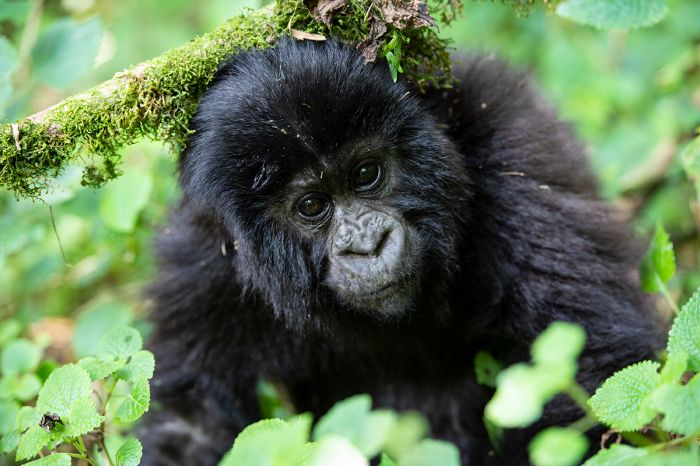
Gorilla treks in Bwindi can be physically demanding (Copyright © James Weis)
Most treks will involve a significant amount of physical exertion, with sections of steep, muddy or slippery trail, depending on the location and recent weather. The hike can also require scrambling over or under dense thickets and undergrowth, navigating fallen trees, and moving on all fours in some places.
Most of the trek involves simply walking on well-used trails, but be prepared for difficult sections. Proper clothing and gear is crucial for gorilla trekking (see our clothing/gear suggestions below for full details).
Preparing for your trek prior to traveling (by doing daily exercise) is strongly recommended. Endurance and a degree of fitness will make your trek much more enjoyable. Keep in mind that you will most likely be hiking in higher elevations that what you are used to at home, which means that the air is thinner and you will tire more easily, regardless of your fitness level.
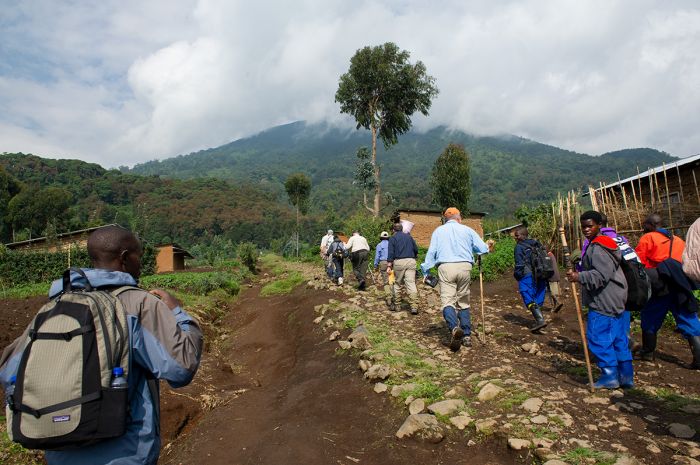
Trekkers in the nearby Virunga Mountains (Copyright © James Weis)
Time with the Gorillas
After following your guide through the forest, which can take 20 minutes to several hours, depending on where your gorilla group is located on that particular morning, you will reach the gorillas. At this point, your guide will give everyone a chance to get their cameras ready and have a last drink of water, before leaving all packs with the porters and approaching the gorillas.
As you approach, your guide will make gorilla vocalizations to announce your presence. These gorilla sounds include moans, grunts, lip smacking and other calls that reassure the gorillas that all is well and that you come as friends. Although gorillas are usually silent and seldom use vocalizations, the guides know how to communicate with them and will use reassuring calls to put the gorillas at ease. The gorillas will also recognize your specific guide, as he or she will be well known to them.
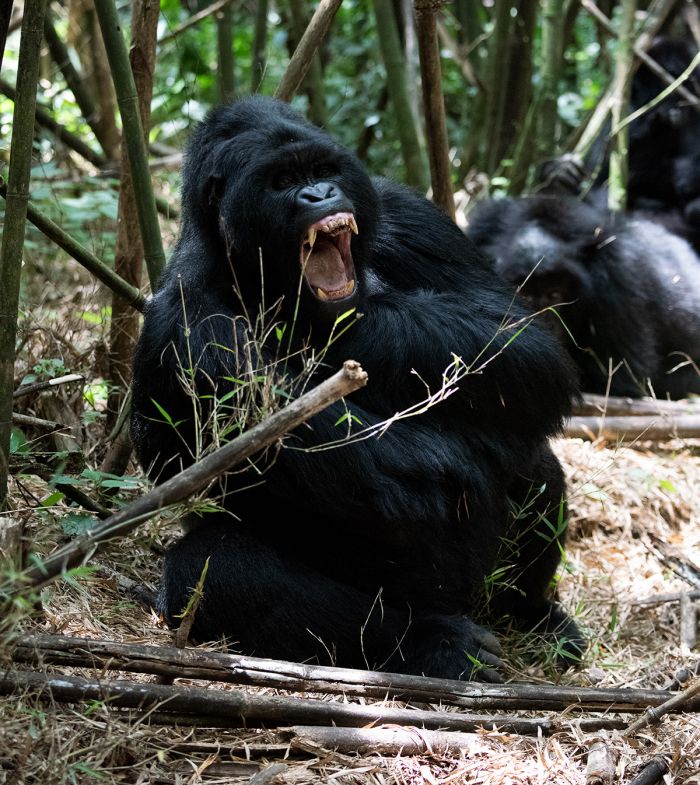
An adult male mountain gorilla seen on a gorilla trek (Copyright © James Weis)
The one-hour time limit begins now and everyone should take advantage of the allotted time by taking lots of pictures and soaking in the experience. Sixty minutes goes by quickly.
Depending on the length of the trek to reach the gorillas, you may be fortunate enough to catch the group during their extended midday leisure period, which makes for excellent photo opportunities. The young gorillas become active and very playful, while the adults groom and relax with one another. The dominant silverback receives lots of attention, especially from the juveniles, who often play on and around him, rolling and wrestling with one another.
Females with infants will nurse their babies and, depending on your proximity to the gorillas, it is possible that a curious young gorilla may approach you and even make an effort to play with you or touch you. If this happens, never reciprocate or attempt to engage with them, as this can result in the young gorilla feeling threatened, which could become a potentially dangerous situation.
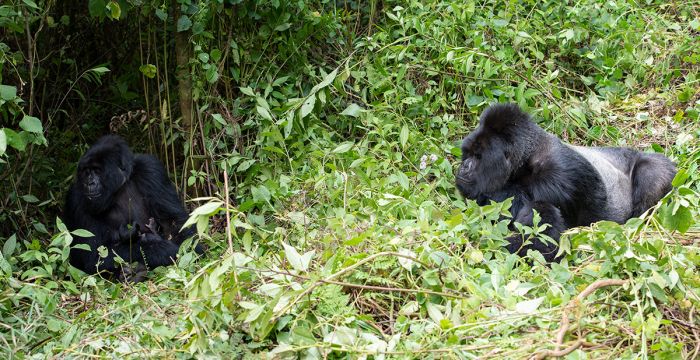
A silverback approaches for a look at his newborn baby (Copyright © James Weis)
During the time spent with the gorillas, the guide will make an effort to get everyone good views and positions for taking pictures by suggesting spots for better viewing angles. Depending on what the gorillas are doing, this may be easy or not entirely possible. Watching where the guide goes and following his or her position is a good way to better your chances for the best possible views.
The one-hour limit for the gorilla interaction is strictly adhered to by the guides. The time limit and keeping a physical distance from the animals protects the gorillas from becoming stressed and also minimizes the chance that viruses may be passed to them. The hour passes much more quickly than you will expect, so take full advantage of the time with the gorillas and enjoy it.
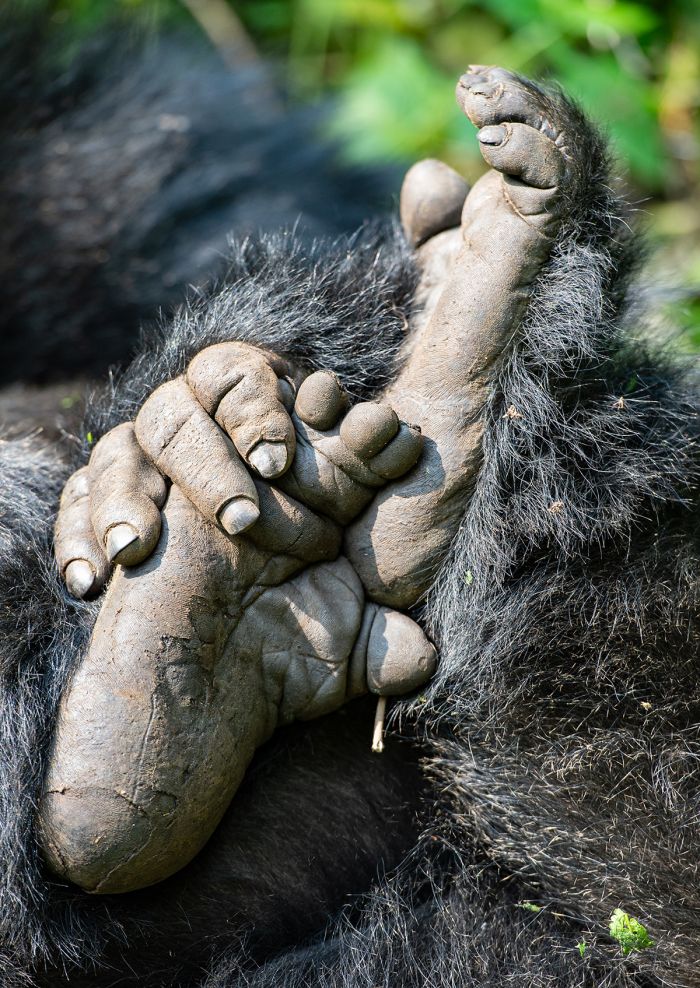
Intimate photography is possible during time with the gorillas (Copyright © James Weis)
Once the 60-minute gorillas interaction has concluded, you will leave the gorillas and rejoin the porters and your backpacks. Everyone will surely be all smiles and and for first-timers, the thrill and adrenaline will be amazing. Before beginning your return trek, now is the time to give an optional gratuity to any gorilla trackers that will stay with the gorillas all day (so that they know the sleeping location of the group for tomorrow's trek).
Depending on the time of day following your session with the gorillas, there may be time for some relaxation, a leisurely snack and cool down period. If the trek to the gorillas was a long one, the guide will get everyone going on the return trek so as not to arrive too late back at the trailhead. Once the trek is completed, please tip your porter, guides, and security personnel that may have accompanied the group. Please see our tipping information below.
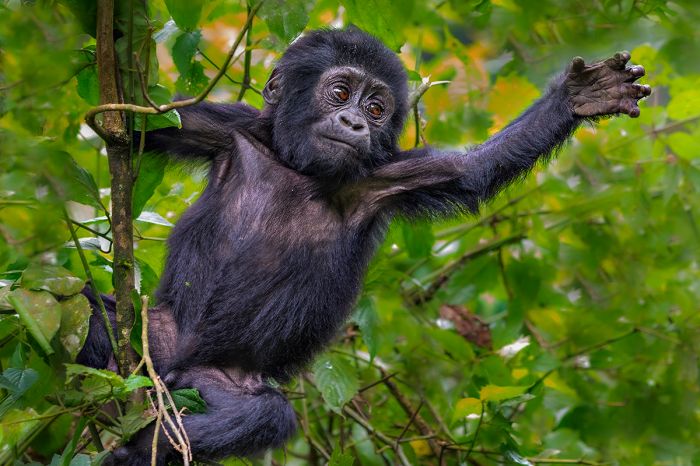
Gorilla groups invariably include young individuals
Trekking Sectors
Bwindi has four main sectors for gorilla trekking, each with one or more habituated gorilla groups. The sectors each have separate trailhead locations that are miles apart, so depending on the location of your accommodation, it may mean a very early rise to reach your staring point on time. Below is some information on each of Bwindi's four trekking sectors.
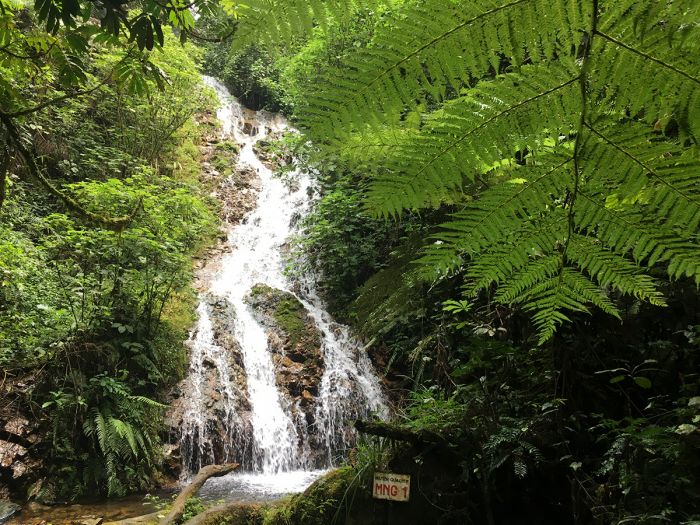
Gorilla trekking in Bwindi takes place in four "sectors", each with it's own trailhead
Buhoma
Located in the northwest of the park, Buhoma is the site of the park's headquarters and Bwindi's oldest and primary gorilla trekking trailhead. There are numerous choices for accommodation around the Buhoma Gate, including several just inside the park. Most of the accommodation at Buhoma is upscale and pricey, but the views on the steep slopes of the Munyaga River valley are lovely.
There are three habituated gorilla groups that are tracked from Buhoma: the Mubare (M-group), Rushegura (R-group), and Habinyanja (H-group). The Mubare group was one of Bwindi's original tourism families, first visited by trekkers in 1993. H-group was first visited by trekkers in 1999, and R-group in 2002. The forest here is dark and damp and treks typically take between three and seven hours, but the success rate, as with all treks in Bwindi, is virtually 100%.
Besides gorilla trekking, Buhoma is considered the best location for guided trail hikes, which will surely include views of numerous monkeys, including a possibility of seeing chimpanzees. The birding on the main trail from Buhoma is nothing short of spectacular. Hiring a guide will greatly enhance the experience, as they are experts at locating wildlife.
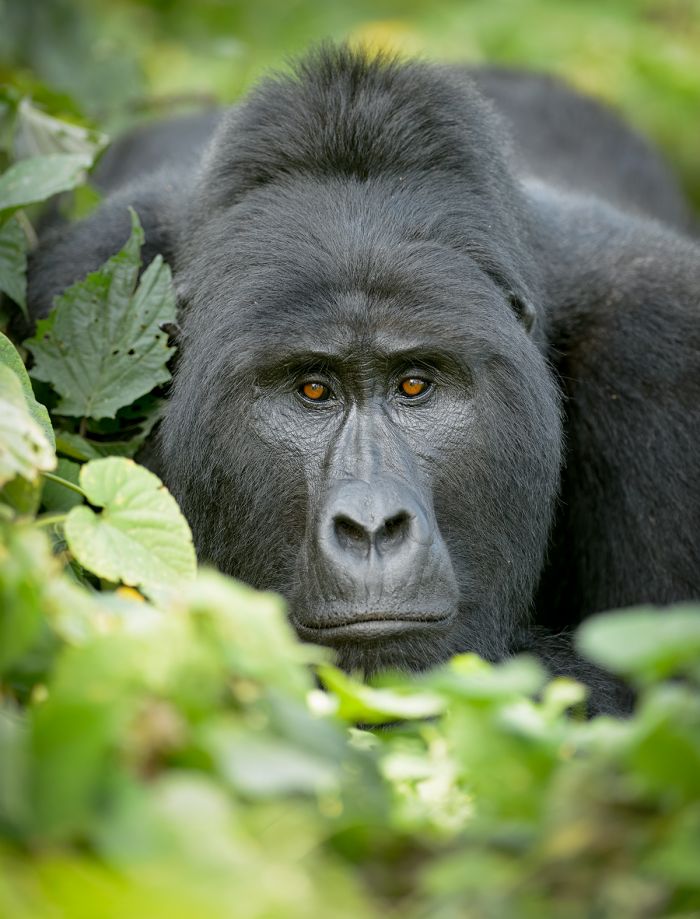
The dominant silverback of the Mubare group in the Buhoma sector of Bwindi
Ruhija
The trailhead at Ruhija leads to Bwindi's highest elevation terrain. The Ruhija Gate sits at 7 560 feet (2 340 meters) in the hilly southeast section of the park. The views from the trailhead look over Bwindi's forested ridges and all the way to the Virunga Mountains in the southwest are breathtaking. The views to the west look over the Rift Valley.
There are three habituated gorilla groups that are visited from Ruhija: Bitukura, Kyaguriro, and Oruzogo. The trails at Ruhija traverse high elevations and the gorilla treks here can be challenging. Bwindi's small elephant population are sometimes seen on Ruhija's trails.
There are several excellent nature hikes that start at the Ruhija trailhead, including a three-hour trail that descends to the Mubwindi Swamp. Another great hike is the six-hour Bamboo Trail, that leads to Rwamunyoni Peak, which at 8 553 feet (2 607 meters), is Bwindi's highest point. All of Ruhija's trails offer excellent birding and opportunities to see some of Bwindi's monkeys, especially the black-and-white colobus, which are common in the area.
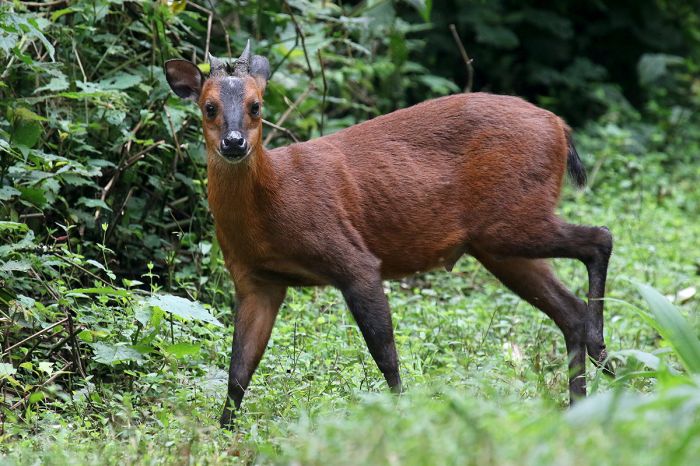
A black-fronted duiker seen in Bwindi's Ruhija sector
Nkuringo
Located in the southwest of the park, Nkuringo became Bwindi's second gorilla trekking trailhead in 2004. There is one habituated gorilla group here, the Nkuringo group, which was habituated in 1997. Gorilla trekking in Nkuringo is by far the most physically strenuous in the park.
The Nkuringo group is usually found along the Kashasha River valley, which lies 2 000 feet (600 meters) below the trailhead, that is located high up one the ridge. The trek begins with a steep one-hour descent just to reach the river and enter the forest. After tracking the gorillas into the forest, the return trip ends with a tough one- to two-hour ascent back up the ridge to the trailhead.
The land outside the park is heavily farmed, but the area is extremely remote, beautiful, and scenic due to a lack of good roads. Hikes along the road atop Nteko Ridge outside the forest provide incredible views over the Bwindi Forest and southwest to the volcanoes of the Virunga Mountains.
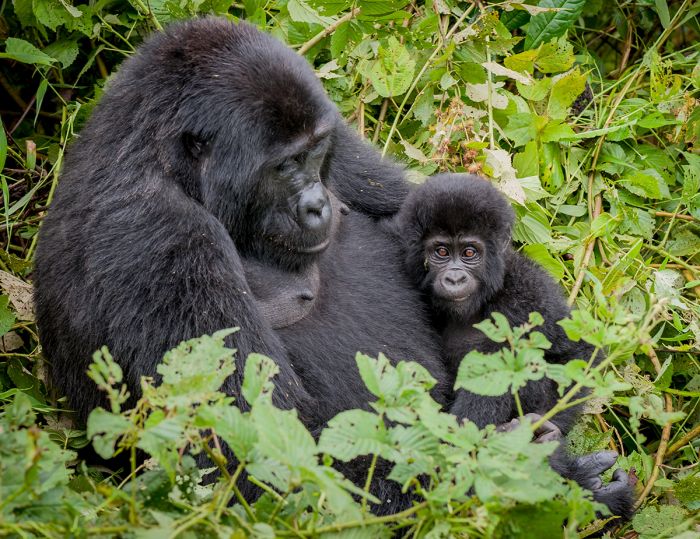
A female and baby of the Nkuringo group in Bwindi
Rushaga
Bwindi's newest gorilla trekking site is at Rushaga, in the far southeast of the park. The trailhead opened in 2009 and offers treks to five habituated gorilla groups: Mishaya, Nshongi, Kahungye, Busingye, and Bweza. Treks begin at the immediate edge of the forest and can involve lengthy hikes, as these gorilla families tend to move around quite a bit.
Like the other trailheads, Rushaga offers nature hikes, one of which leads to a beautiful waterfall. Birding in this sector is also outstanding.
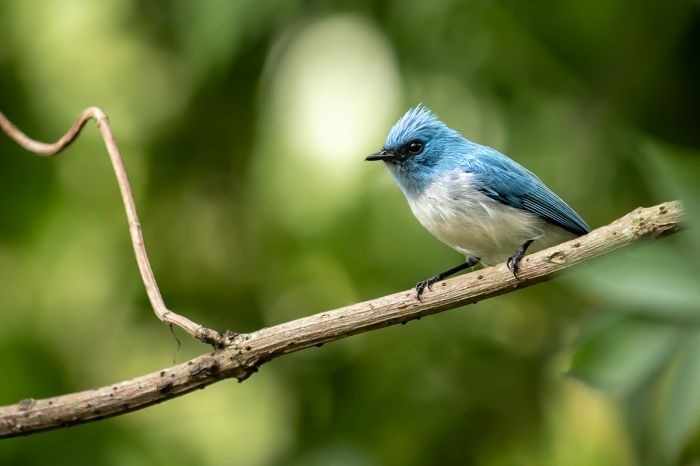
Birding is wonderful throughout all of Bwindi's sectors; African blue flycatcher
Other Trekking Considerations
Clothing and Gear
Gorilla trekking involves unpredictable weather and hiking conditions - it can rain on any day (even during the 'dry' season) and even if the weather is sunny, recent rains can mean muddy trails. Besides the weather and trail conditions, your trek will also invariably involve moving through portions of thick underbrush, some of which (like stinging nettles) are unpleasant to touch and can cause severe itching.
Lastly, temperatures in the forest can vary greatly even on a single trek. The upper elevations of Bwindi can be chilly, while the river valleys are often muggy and hot. For these reasons, being prepared with the proper clothing and gear is essential to an enjoyable trek.
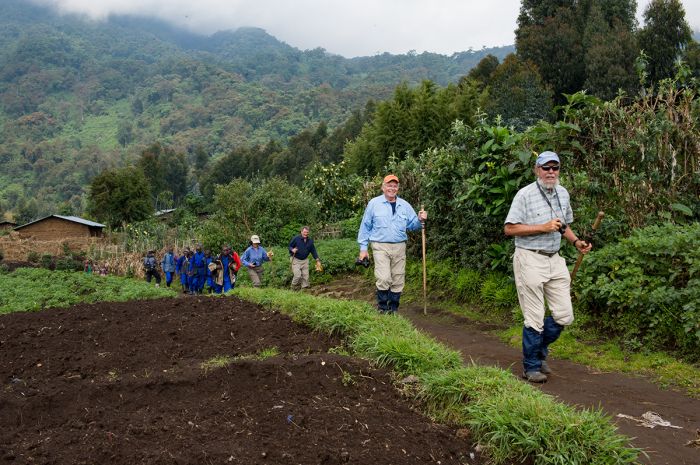
Proper clothing and gear is important for an enjoyable gorilla trek (Copyright © James Weis)
The following list includes our recommended items to bring for your gorilla trek:
- Lightweight, frameless, waterproof back/day pack. This pack can be carried by your porter and should be large enough to carry your clothing, food, water, and camera.
- Light, waterproof hiking boots or shoes with treaded soles. Mid-height (over the ankle) hikers are best.
- Hiking socks and gaiters to wear over your pants and shoes.
- Leather or heavy canvas (gardening-style) gloves for moving through the vegetation and especially avoiding any contact with stinging nettles.
- Thin, lightweight, pullover waterproof rain pants to wear over your pants.
- Waterproof shell top with hood.
- Base layer top (sweat-wicking) with a second layer cotton, long sleeve layer over the base.
- Fleece top for the early morning.
- Long pants worn under the rain pants should be the light-weight trekking variety. Some trekkers wear their waterproof pants over long underwear instead of pants.
- Hat to provide rain/sun protection.
- Bottles of water (bring more than you think you'll need).
- Energy bars or other high-energy snacks to keep you fueled.
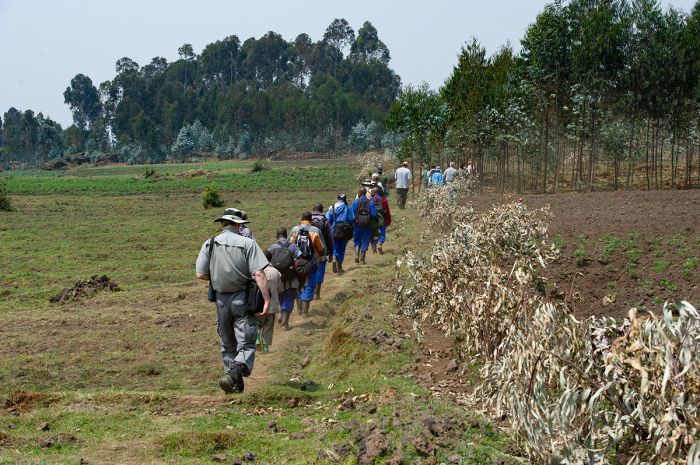
A gorilla trek en route to see the mountain gorillas (Copyright © James Weis)
Weather
Gorilla trekking in Bwindi takes place year-round, even on rainy days. Rain makes for a more challenging trek, as the ground can become muddy and viewing the gorillas during a shower limits photography. Nonetheless, the gorillas are used to the regular rain and are not particularly bothered by it, so they usually continue most activities rain or shine.
Dry Season: June-September and January-February are considered the 'dry' months and offer the best chances for rain-free gorilla trekking conditions, but be prepared for afternoon rain at any time. Clear, sunny days are the norm at this time.
Rainy Season: Most rainy days occur from March to mid-May and again during October-November.
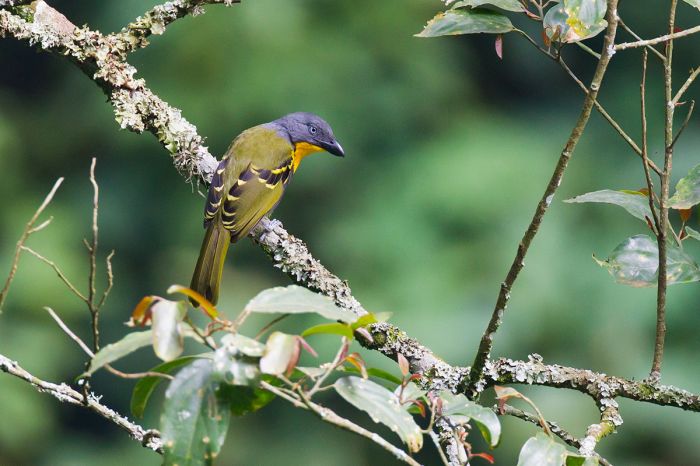
Birding in Bwindi is very good - Lagden's bushshrike
Tipping Guidelines
The following are our suggestions for tipping your gorilla trekking guides, trackers and porters. Feel free to tip more or less at your discretion.
- Porter US USD 10 per trek.
- Gorilla Trek Guide USD 20 per trek.
- Gorilla Trek Assistant Guide USD 10 per trek.
- Gorilla Trackers USD 5 per tracker per trek (usually 3 or 4 trackers are used to find the gorillas).
- Gorilla Security trekker USD 5 per trek.
Please bear in mind that the porters do not earn any salary, and if you do choose to hire a porter (highly recommended) or two, he or she will depend fully on your tip for income. Guides (1-2 per group), Trackers (2-4 per group) and Security personnel (1-2 per group) do earn salaries.
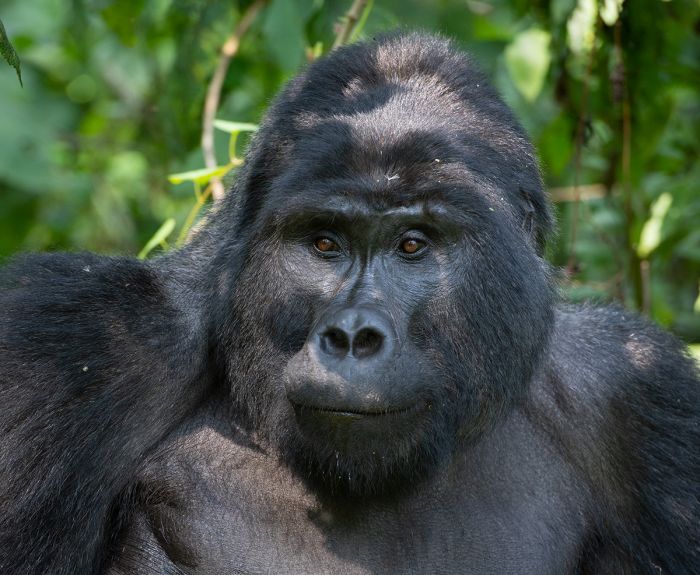
The Mishaya group's silverback (Rushaga sector) (Copyright © James Weis)
Trekking Regulations and Rules of Conduct
It is important that all gorilla trekking participants familiarize themselves with the following regulations and rules of conduct:
- Follow the instructions of your guide. He or she is in contact with the gorillas on a regular basis and understands them well. Always remain in a quiet, compact group behind the guide, who will attempt to position you in such a way that the dominant male of the group can see you at all times.
- If the dominant male gorilla (usually a silverback) approaches very closely or if he charges, it is very important that you do not move backwards. Remain exactly where you are, look downward, and adopt a submissive, crouched posture. Do not make any sudden moves or loud noises in the presence of the gorillas.
- If a young gorilla approaches, do not make any move to touch or engage with it. Your guide, in certain instances, may take steps to discourage a youngster from touching you, as this could create a threatening situation with the dominant male.
- Do not use a flash when photographing the gorillas.
- Only visitors in good health will be permitted to track gorillas, as gorillas are susceptible to common colds and other respiratory diseases or viruses transmitted by humans. All visitors should be physically fit and capable of enduring a walk of several hours in difficult terrain (as described above).
- Each gorilla family may be visited only once each day by a maximum of eight trekkers for a maximum duration of one hour. Due to the very limited number of persons allowed to visit the gorillas each day, it is not possible to do gorilla tracking on a private basis.
- Smoking, eating, and/or drinking is not permitted during the one-hour gorilla visit.
- It is prohibited to destroy any vegetation unnecessarily in the national park. The flora and fauna are strictly protected. All visitors must carry their own litter with them out of the park, leaving nothing behind.
- Children under the age of fifteen (15) cannot participate in gorilla tracking.
- Trekkers should be in good physical condition and be physically and mentally prepared to walk long distances over rough terrain if that is where the search for gorillas takes them.
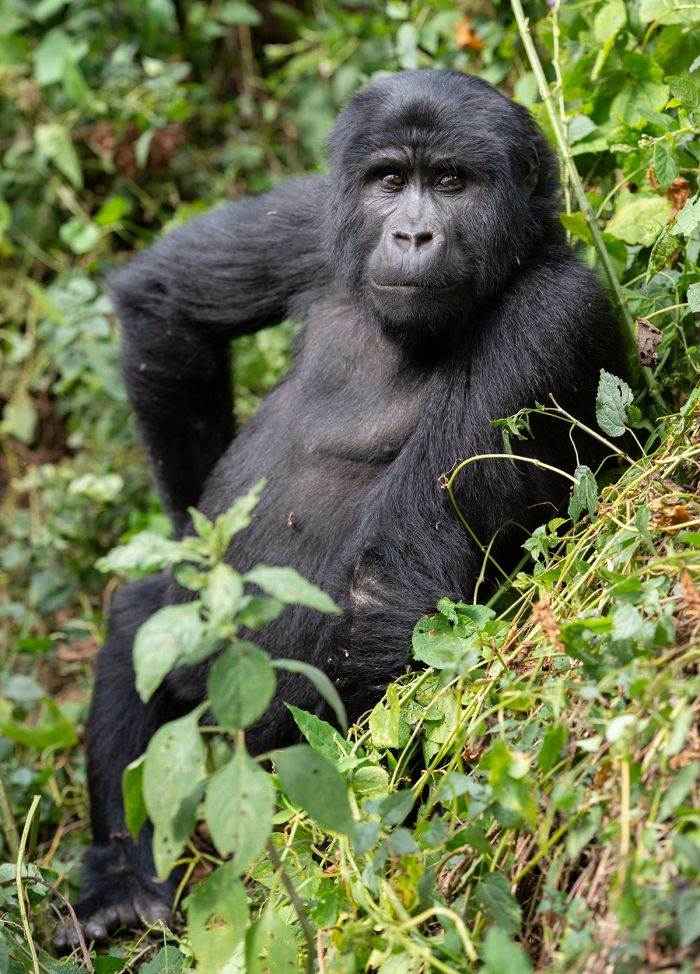
A sub-adult of the Bitukura group (Ruhija sector) (Copyright © James Weis)
Note of Disclaimer
Eyes on Africa/Eyes on Adventure (EOA) does not control the administration nor play any part in the operation of Rwanda's national parks or reserves. These areas are the total responsibility of local authorities. If the local staff observes situations that merit improvement, they will request that park authorities make changes, but these authorities are under no obligation to do so.
While EOA and its local operators have cultivated an excellent relationship with the national park authorities and they are always eager to help us look after our clients, it is they who operate the actual gorilla tracking excursions, not EOA, nor its local operators. It should also be noted that EOA and its local operators do not employ any of the local guides, gorilla trackers nor porters, and therefore, EOA cannot accept responsibility for the manner in which they conduct themselves.
Travelers should keep in mind that the gorilla guides and trackers are local, native-born people who have spent a lot of time in the forest with the gorilla families and that they probably have very good reasons to do things a certain way.
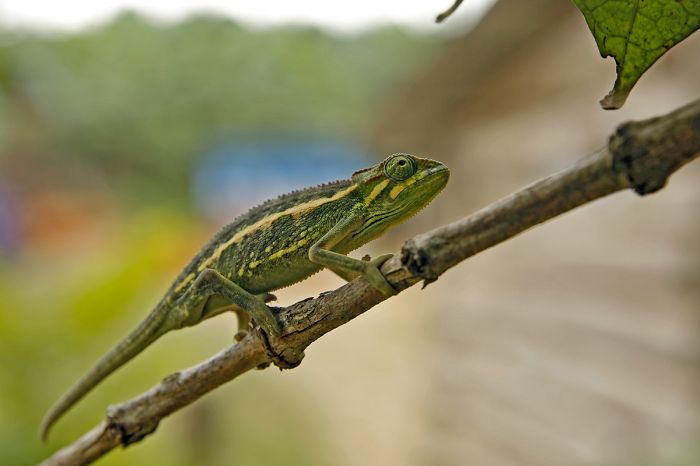
A flap-necked chameleon seen on hike in the Bwindi Impenetrable Forest
GORILLA Conservation & TOURISM
Mountain gorilla tourism began in Rwanda on a small scale in 1979, but trekking for gorillas really took off after the tragic death of Dian Fossey in 1985. Fossey's death gained worldwide attention and brought her fight to save the mountain gorillas from extinction to a global audience.
The release of Gorillas in the Mist, a major motion picture about Dian Fossey and her 18-year study of the mountain gorillas in Rwanda, was an international success that led to a massive surge in ecotourism for gorilla trekking. While Rwanda captured much of the early tourism gains, Uganda also profited from the gorillas' new popularity.
Gorilla trekking in the Virunga Mountains began in 1979 and experienced huge growth in the late 1980s, which led to much improved anti-poaching and conservation efforts in Rwanda. In Uganda, the first habituation process of a gorilla group (the Mubare group) began in 1991, with the first commercial trekking beginning in 1993.
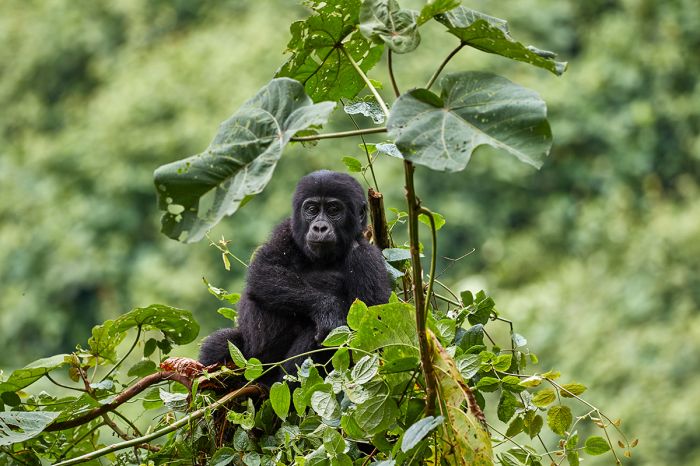
A young mountain gorilla in Bwindi
Over the last 40-50 years, the Virunga population of mountain gorillas has been the subject of much research and several censuses, while the Bwindi population has only been well studied since the early 2000s.
In the early 1980s, the population of mountain gorillas in the Virunga Mountains (which does not include the Bwindi population) was estimated at only 240 individuals. Later, in 1989, another census of the Virunga gorillas established that the population had grown to 325.
The first complete census of Bwindi's gorillas was carried out in 1997, establishing the population at 300 individuals. Another survey of the Bwindi population took place in 2011 and resulted in a count of 400 gorillas.
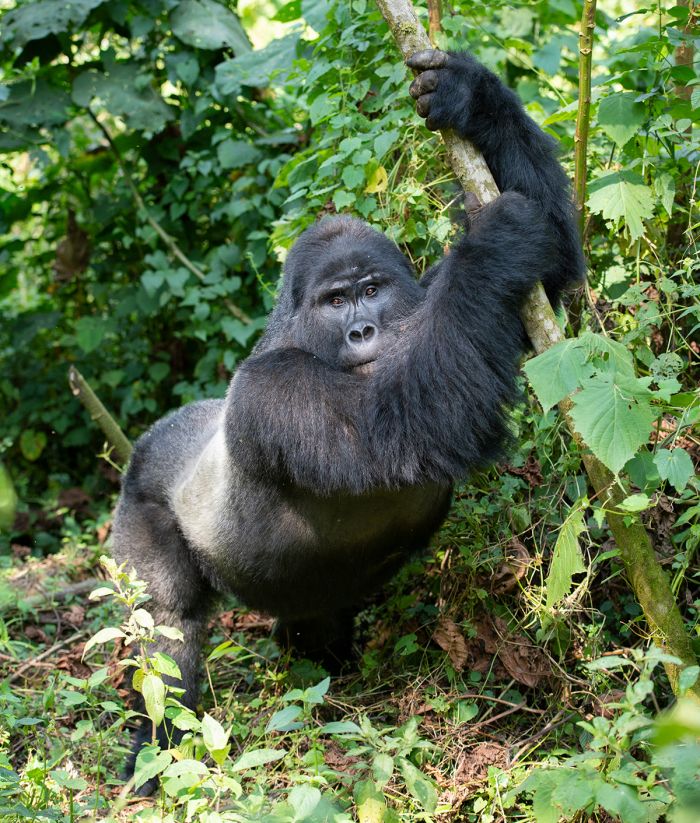
The Mishaya group's silverback (Copyright © James Weis)
Most recently, a 2016 survey of the Virunga population revealed its population to be 604 gorillas. The latest census, which accounts for all mountain gorillas, including those in Bwindi and the Virungas, shows that there are at least 459 in Bwindi and 604 in the Virungas, resulting in a total count of 1 069 mountain gorillas.
The 1 000 or so mountain gorillas remaining is indeed a very small number and they are still critically endangered, but during the period of time when Dian Fossey was working with wild gorillas in Rwanda's Volcanoes National Park (in the 1970s-1980s), it was believed probable that mountain gorillas would become extinct by the year 2000.
Conservation efforts, especially the gorilla-trekking ecotourism industry, has been a huge success, proving that the efforts being made to protect the mountain gorillas are working. Investing local people in the trekking industry has been a big part of this success.
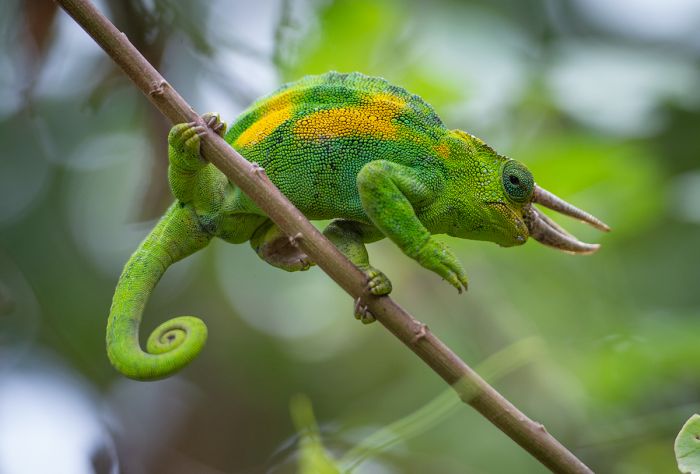
A Jackson's three-horned chameleon seen on a gorilla trek in Bwindi (Copyright © James Weis)
Read More...
Mountain Gorillas: Activity, Diet, Discovery, Gorilla Conservation, Gorilla Tourism, Habitat, Physicality, Reproduction, Society, Taxonomy
Gorilla Trekking: Background, Clothing & Gear, Permits & Pre-Trek, Time with Gorillas, Tipping, Trekking Details, Trekking Rules, Weather
Geography/History: Flora, Geography, History, Trekking Sectors, Wildlife
Great Good Fair Poor
- Jan
- Feb
- Mar
- Apr
- May
- Jun
- Jul
- Aug
- Sep
- Oct
- Nov
- Dec
Bwindi is a year-round destination, but for gorilla trekking and hiking, the "dry" period (June thru early September) is best, as the trails are easier to navigate. Being a true rainforest, Bwindi can receive rainfall on any day, including during the driest months.
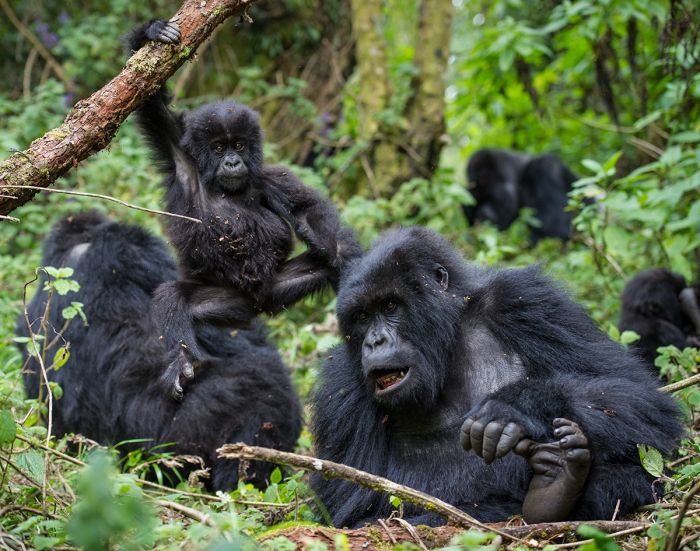
Gorilla trekking is a year-round activity (Copyright © James Weis)
Climate
Bwindi lies only 0.5 degrees south of the equator and enjoys a wet, tropical climate. Temperatures remain consistently warm throughout the year, ranging between 68-81°F (20-27°C) during the day and falling to 50-54°F (10-12°C) at night.
Bwindi is a rainforest and it receives rain throughout the year, but the months of June, July, and August receive the least rainfall. The wettest months are November and April, but rain can be expected, at least in the form of short showers, on any day from mid-September thru mid May.
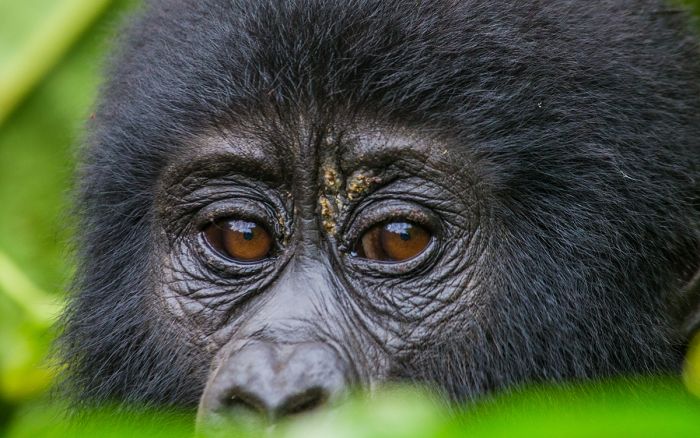
A young gorilla seen on a gorilla trek in Bwindi
Gorilla Treks
The busiest time for gorilla trekking in Bwindi is predictably during the driest months of June, July and August. This is the most reliable time of year to experience a rain-free day and those planning a trip during this period are advised to book early and obtain gorilla permits at the time of booking.
Rain can occur on any day in Bwindi, but gorilla trekking proceeds regardless of the weather. Hiking on the forest trails is much easier when the paths are dry, as recent rain can cause muddy and slippery conditions in places.
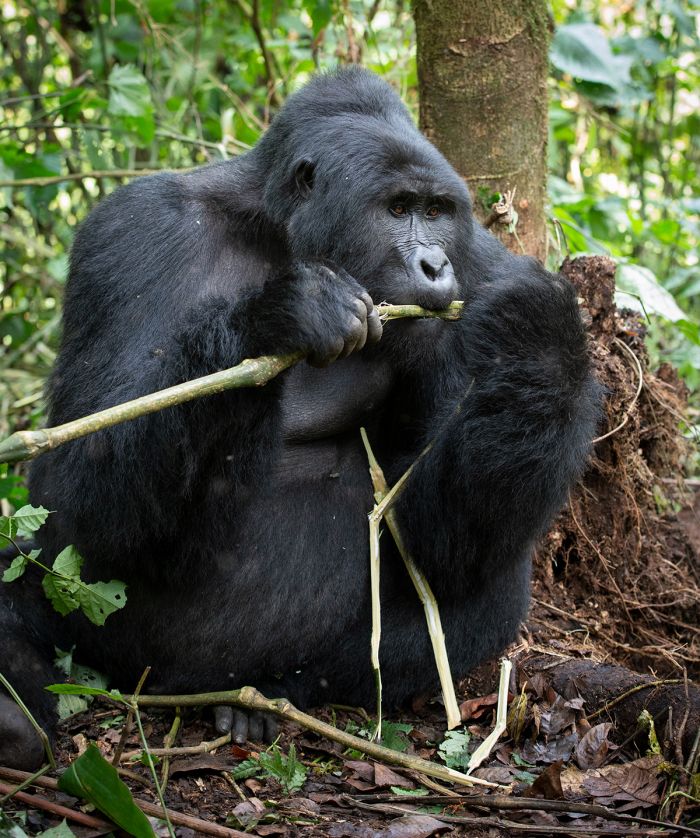
A silverback enjoys some food in Bwindi (Copyright © James Weis)
Rain gear (pullover waterproof pants, rain shell, boots/hiking shoes, and hat) should be brought along on any trek, regardless of the time of year. Don't forget rain protection for electronics and cameras. For our full list of recommended trekking clothing and gear, please visit the previous tab.
Should it rain during your gorilla trek in Bwindi, do not be overly concerned, as the gorillas are quite used to rain and will carry on with their daily activities regardless of the weather. Unless there is a heavy downpour, during which the gorillas may hunker down to wait out the storm, the experience will still be rewarding and photography can even be amazing, with wet fur making for interesting images.
Finally, permits are easier to obtain outside of the prime trekking months and may even be discounted in price. The same goes for accommodation in and around the park.
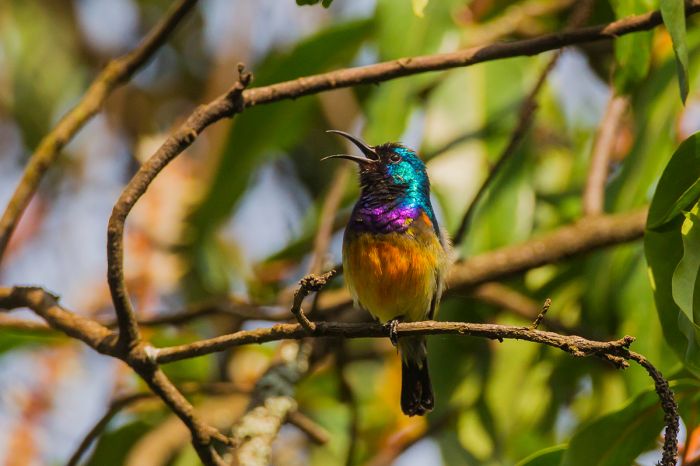
A variable sunbird (Orange-chested subspecies) in Bwindi




